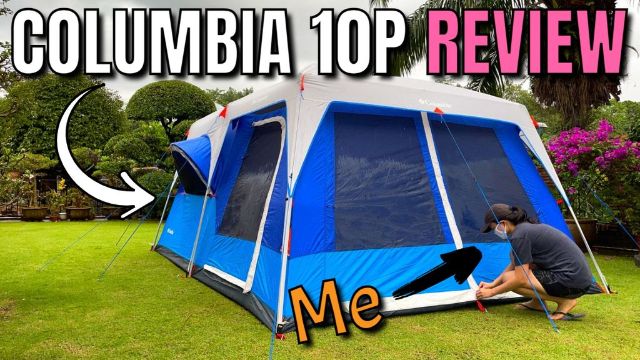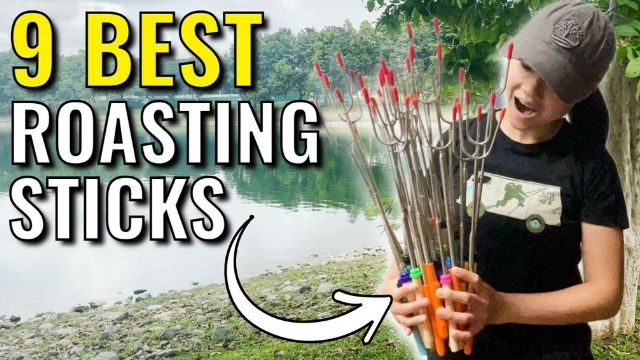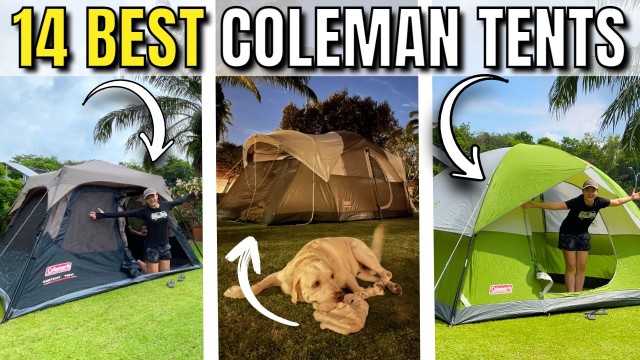I Tested the 6 BEST 10-Person Tents! (2025)
This page contains affiliate links, and that means that I may earn a commission if you buy something, at no extra cost to you. You can find my full disclosure policy here.
For this review, I bought and tested these 6 BEST 10-person tents:
- Columbia Mammoth Creek 10-Person Tent;
- Coleman WeatherMaster 10-Person Tent;
- Coleman 10-Person Instant Cabin Tent;
- Outdoor Products 10-Person Instant Cabin Tent;
- Core Equipment 10-Person Straight Wall Cabin Tent; and
- Ozark Trail 10-Person Cabin Tent.
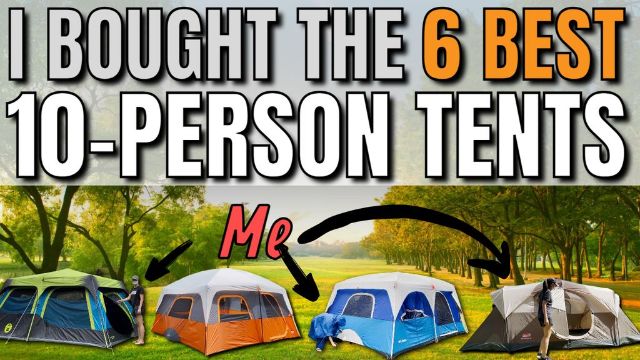
Summary
Here’s a summary of all the 10-person tents that I recommend (after buying and testing, of course):
| 10P Tent | Recommendation | Score | Price |
|---|---|---|---|
 |
BEST PREMIUM PICK Columbia Mammoth Creek 10-Person Tent
|
||
 |
BEST VALUE FOR MONEY Coleman WeatherMaster 10-Person Tent
|
||
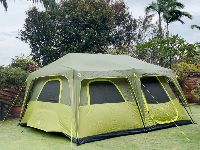 |
BEST INSTANT PICK Outdoor Products 10-Person Instant Tent
|
||
 |
BEST BLACK OUT PICK Coleman 10-Person Instant Cabin Tent
|
||
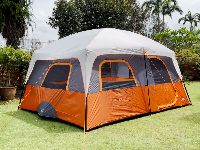 |
MOST SPACIOUS Core 10-Person Straight Wall Cabin Tent
|
||
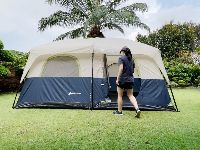 |
BUDGET PICK Ozark Trail 10-Person Cabin Tent
|
Here’s my YouTube video on the best 10-person tents. Clicking on the video below will direct you over to YouTube where you can watch it.
If you enjoyed the video, please consider subscribing to my YouTube channel right here:
All the 10-person tents that I bought and tested:
| 10P Tent | Full Review | Check Price |
|---|---|---|
| Columbia 10P | Read Review | Amazon |
| WeatherMaster 10P | Read Review | Amazon |
| Outdoor Products 10P | Read Review | Amazon |
| Coleman Instant 10P | Read Review | Amazon |
| Core 10P | Read Review | Amazon |
| Ozark Trail 10P | Read Review | Amazon |

*These are my measured specifications and data of the 6 best 10-person tents, and may differ from the brand’s marketed specifications:
| 10P Tent | Peak Height | Base Area | Packed Size | Weight | Set Up (1P) | Take Down (1P) |
|---|---|---|---|---|---|---|
| Columbia Mammoth Creek 10-Person Tent | 80 inches | 138.0 square feet | 30 x 14 x 12 inches | 34.4 pounds | 28 minutes | 16 minutes |
| Coleman WeatherMaster 10-Person Tent | 80.5 inches | 143.6 square feet | 31 by 18 by 12 inches | 30.6 pounds | 19 minutes | 16 minutes |
| Outdoor Products 10-Person Instant Tent | 77.5 inches | 135.8 square feet | 50 by 17 by 12 inches | 32.8 pounds | 12 minutes | 8.5 minutes |
| Coleman 10-Person Instant Cabin Tent | 73.5 inches | 135.7 square feet | 50 by 17 by 12 inches | ~31 pounds | 16 minutes | 10 minutes |
| Core 10-Person Straight Wall Cabin Tent | 90 inches | 135.8 square feet | 29 x 16 x 12 inches | 30.5 pounds | 22 minutes | 13 minutes |
| Ozark Trail 10-Person Cabin Tent | 88 inches | 136.4 square feet | 29 by 18 by 13 inches | 30.0 pounds | 20 minutes | 12 minutes |
If you need more info on the specifications of each 10-person tent, click here for the more detailed tables.
I spent over $1,500 buying these 6 best 10-person tents, 6 weeks testing them out, and another 2 months after that putting this review together.
Over these 6 weeks of intensive testing, I set up and took down each 10-person tent at least half a dozen times, rain tested each one thoroughly, slept in one of tents every single night, amongst other things.
After all that, here’s how I scored each of the six 10-person tents (10 is the best, 1 is the worst):
| 10P Tent | Overall Rating |
|---|---|
| Columbia 10P | 8.5 |
| Outdoor Products 10P | 8.3 |
| WeatherMaster 10P | 7.7 |
| Coleman Instant 10P | 7.6 |
| Core 10P | 7.4 |
| Ozark Trail 10P | 6.2 |
Top Picks
1. Columbia Mammoth Creek 10-Person Tent (Best Premium Tent)
Key Info
- Peak Height: 80 inches
- Length: 13 feet 11 inches
- Width: 9 feet 11 inches
- Base Area: 138.0 square feet
- Material: 150D Polyester (Flooring), 75D Polyester (Tent and Rainfly), Fiberglass and steel (Poles), SBS (Zippers), No-see-um (Mesh)
- Packed size: 30 x 14 x 12 inches
- Weight: 34.4 pounds
- Storage: 2 pockets, 2 lantern loops
- Ventilation: 4 windows, 2 doors, 1 ground vent, ceiling mesh
- Other Features: Pull-out windows (2), Room divider (1), E-port (1)
- Set Up Timing: 14 minutes (2 people), 28 minutes (1 person, not recommended)
- Take Down Timing: 8.5 minutes (2 people), 16 minutes (1 person)
Pros and Cons
Summary
Of all my 10-person tents, the Columbia Mammoth Creek Tent is my highest quality, most feature-rich, most water-resistant, most ventilated tent. How so? Well, here’s a quick summary.
This Columbia 10-Person Tent did the best in my rain test, and passed my 1-hour heavy rain test with flying colors.
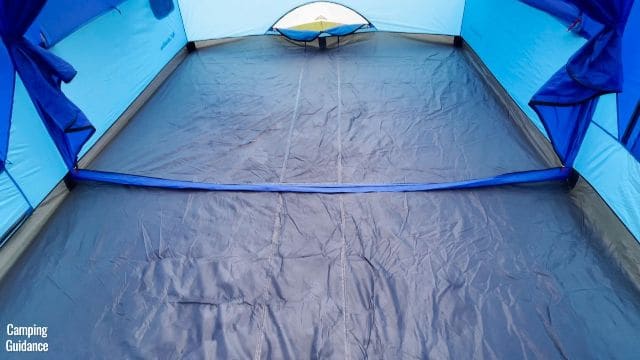
Plus, it has the most ventilation when it’s raining (with not just 2 pull-out windows, but with 1 ground vent as well) and is my only tent that came with all its seams taped.
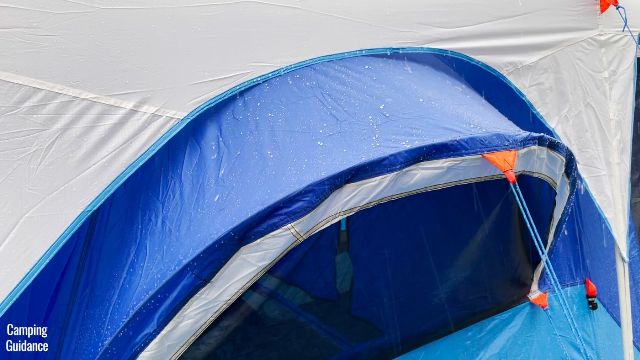
This Columbia T-door is the biggest door in any of my 10-person tents, and the divider is full length with no gaps at all.
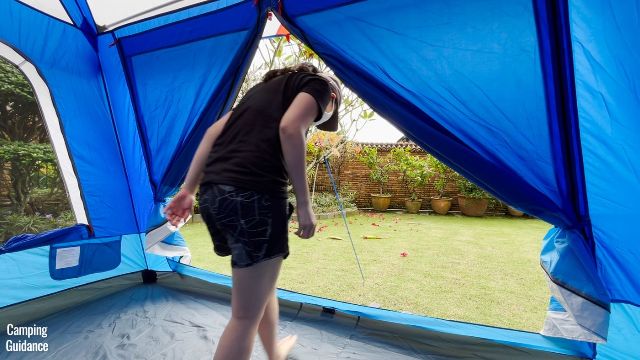
To top it all off, the quality is superb, from the crunch-free 150D polyester flooring to the super smooth SBS zippers.
The design is so thoughtful as well – both doors come rain protected on both the outside and inside, it has the most guylines (10 of them) of any of my 10-person tents, and the most poles and pole clips for the most livable space possible.
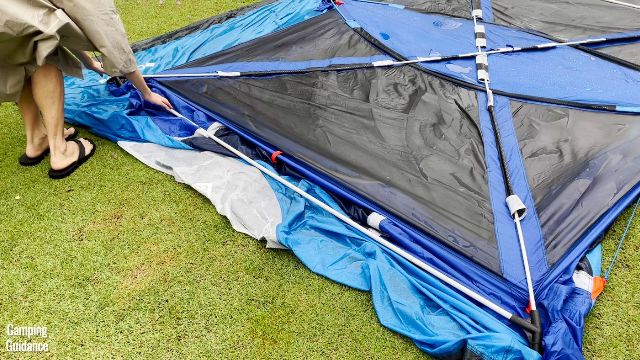
With all these extra features, it’s no wonder that the Columbia is my 10-person tent that takes the longest to set up. It’s also the most expensive 10-person tent that I paid for. But hey, if you need an all-in-one 10-person tent for any occasion, rain or shine, this Columbia 10-Person Tent has got you covered.
More info on the Columbia Mammoth Creek:
2. Coleman WeatherMaster 10-Person Tent (Best Value for Money)
Key Info
- Peak Height: 80.5 inches
- Longest Length: 16 feet 8 inches
- Longest Width: 9 feet 1 inch
- Base Area: 143.6 square feet
- Material: Polyethylene (Flooring), 68D Polyester (Tent), 75D Polyester Taffeta (Rainfly), Steel and Fiberglass (Poles)
- Packed size: 31 by 18 by 12 inches
- Weight: 30.6 pounds
- Storage: 4 pockets, 1 lantern loop
- Ventilation: 4 windows, 2 doors, ceiling mesh
- Other Features: Angled windows (2), Hinged door (1), Room divider (1), E-port (1)
- Set Up Timing: 10 minutes (2 people), 19 minutes (1 person)
- Take Down Timing: 8.5 minutes (2 people), 16 minutes (1 person)
Pros and Cons
Summary
I’ve had the WeatherMaster 10-Person Tent for about 3 years now, and it’s still in great condition, which speaks volumes about its durability and quality.
On top of that, the WeatherMaster Tent has tons of great features, like a super user-friendly hinged D-door, as well as 2 huge angled windows on both widths of the tent.
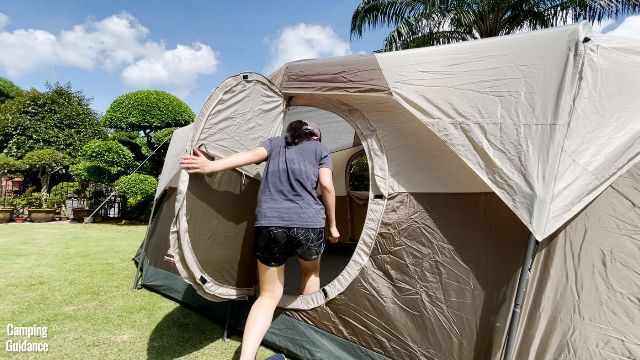
And here’s the cherry on top – it’s actually very inexpensive, especially considering the features that you get. Plus, the WeatherMaster Tent scored almost as well as my more expensive tents, yet cost me a whopping ~40% less.
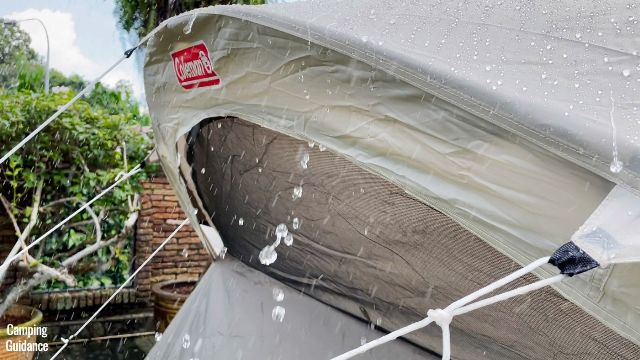
It’s the 10-person tent that I used the most often over the past few years, and I certainly got my money’s worth out of it.
If you’re expecting rain though, you’d need to seam seal the inverted seam connecting the tent body to the bathtub flooring (see picture below).

More info on the WeatherMaster Tent:
3. Outdoor Products 10-Person Instant Cabin Tent (Best Instant Tent)

Key Info
- Peak height: 77.5 inches
- Length: 13 feet 7 inches
- Width: 10 feet
- Base Area: 135.8 square feet
- Material: Polyethylene (Flooring), 68D Polyester (Tent and Rainfly), Steel (Poles), No-see-um (Mesh)
- Packed size: 50 by 17 by 12 inches
- Weight: 32.8 pounds
- Storage: 2 pockets, 4 lantern loops
- Ventilation: 3 windows, 3 doors, 1 ground vent, ceiling mesh
- Other Features: Pre-attached poles and pole clips, Room divider (1), E-port (1)
- Set Up Timing: 6 minutes (2 people), 12 minutes (1 person)
- Take Down Timing: 4.25 minutes (2 people), 8.5 minutes (1 person)
Pros and Cons
Summary
This Outdoor Products 10-Person Instant Tent has an extremely easy and fast set up. It only took my brother and I 6 minutes to set it up completely, and by myself, it was only 12 minutes. That’s incredible for a 10-person tent.

Even packing the tent up was easy, and air didn’t get trapped inside when stuffing it back into the bag.

The entire instant tent mechanism is high quality, with 3 hubs for more livable space, and even these extended eaves that hold the rainfly away from the tent body.

On top of that, this Outdoor Products Tent has awesome features, like a whopping 3 doors, 1 of which is a huge T-door, and even a full-length room divider for privacy.
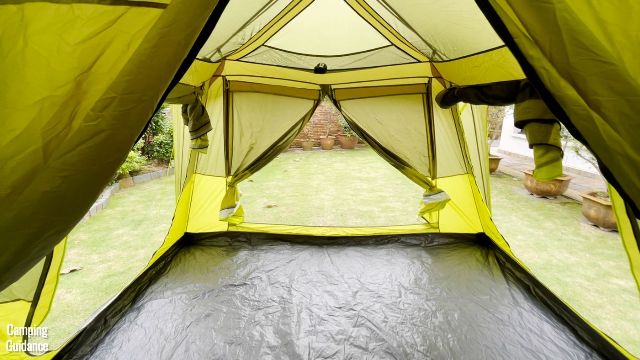
Just bear in mind that instant tents have a much bigger packed size than traditional tents of the same capacity.
Here’s what the Outdoor Products 10-Person Instant Tent looks (~50 inches long) like compared to regular 10-person tents (~30 inches long). Quite a bit bigger, huh?
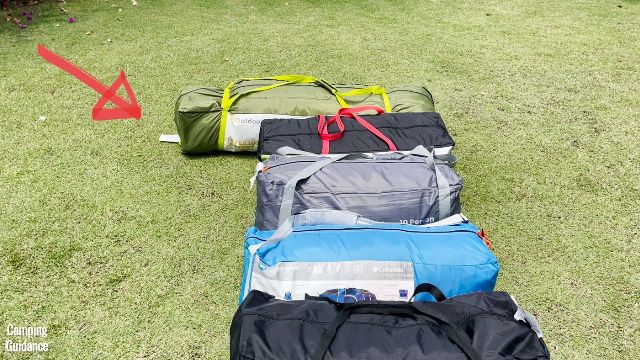
More info on the Outdoor Products Tent:
4. Coleman 10-Person Instant Cabin Tent (Best Blackout Tent)
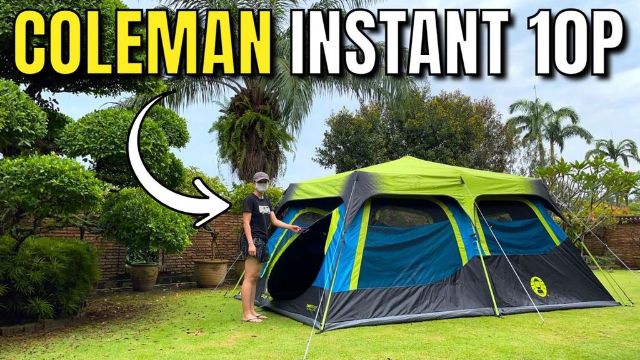
Key Info
- Peak Height: 73.5 inches
- Length: 13 feet 11 inches
- Width: 9 feet 9 inches
- Base Area: 135.7 square feet
- Material: Polyethylene (Flooring), Polyester (Tent and Rainfly), Steel (Poles)
- Packed size: 50 by 17 by 12 inches
- Weight: ~31 pounds
- Storage: 2 pockets, 1 lantern loop
- Ventilation: 5 windows, 2 doors, ceiling mesh
- Other Features: Pre-attached poles and pole clips, Hinged door (1), Room divider (1), E-port (1), Dark room technology
- Set Up Timing: 7.5 minutes (2 people), 16 minutes (1 person)
- Take Down Timing: 5 minutes (2 people), 10 minutes (1 person)
Pros and Cons
Summary
The Coleman 10-Person Instant Tent sets up anywhere between 30 to 90% faster than traditional tents. While it’s slightly slower than the Outdoor Products Tent (above), that’s because the Coleman Tent comes with this hinged D-door that you need to install with fiberglass poles, which is super user-friendly for going in and out of the tent:
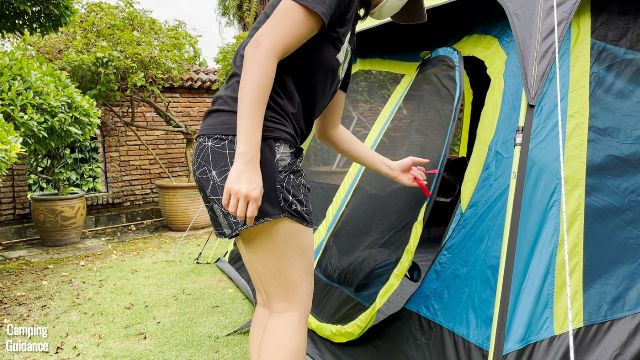
On top of that, there are 2 other ways that this Coleman 10-Person Instant Tent blows all the other 10-person tents in this review out of the water.
First, the dark room technology is phenomenal. Not only is it a lot darker inside the tent during the day, it’s also a lot cooler as well, so it’s great for sleeping in.
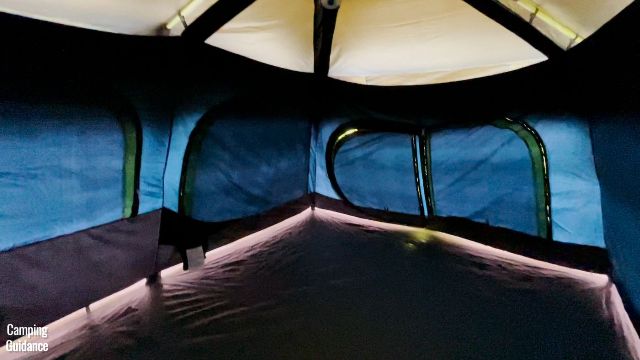
And second, it has a whopping 5 windows and 2 doors with humongous mesh panels, so you’d get an estimated ~9,400 square inches of ventilation when they’re all open on a hot day, which is the most of all these 10-person tents.
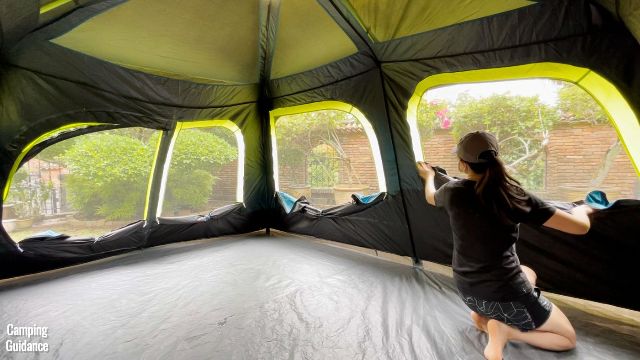
Unfortunately though, this Coleman 10-Person Instant Tent has the least livable space of all these 10-person tents. Its peak height of 73.5 inches is lower than all the other 10-person tents, the tent body feels a bit droopy on the widths of the tent, and the side walls aren’t as vertical as I expected them to be.

But as long as you’re not trying to pack 10 people into this tent, you’re good to go. (I think it would fit 6 comfortably.)
Also, if you’re expecting any rain at all, you do need to seal this inverted seam.

And there won’t be much ventilation when it’s raining, cos you’d need to close all the windows, and there are no vents.
That being said, I’d highly recommend this Coleman 10-Person Instant Tent for hot summer days with high temperatures, but not if you’re expecting plenty of rain.
More info on the Coleman 10-Person Instant:
5. Core 10-Person Straight Wall Cabin Tent (Most Spacious)
Key Info
- Peak Height: 90 inches
- Length: 13 feet 7 inches
- Width: 10 feet
- Base Area: 135.8 square feet
- Material: Polyethylene (Flooring), 68D Polyester (Tent and Rainfly), Steel and Fiberglass (Poles), 210D Polyester (Carry Bag)
- Packed size: 29 x 16 x 12 inches
- Weight: 30.5 pounds
- Storage: 2 pockets, 1 lantern loop, 1 gear loft
- Ventilation: 4 windows, 2 doors, 2 ground vents, ceiling mesh
- Other Features: Room divider (1), E-port (1)
- Set Up Timing: 11 minutes (2 people), 22 minutes (1 person)
- Take Down Timing: 7 minutes (2 people), 13 minutes (1 person)
Pros and Cons
Summary
I really enjoyed the spaciousness of the Core 10-Person Straight Wall Cabin Tent. It has the highest and most impressive peak height of all these 10-person tents, coming in at 90 inches, which is great especially for taller people.
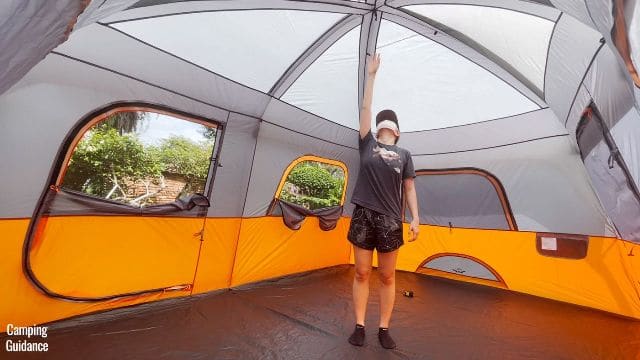
Even the lowest height in the Core 10-Person Tent, which is at the 4 corners, is a whopping 65 inches. This is taller than my entire height! I’m only 5’3″, and I could stand up straight even right at the corner of the tent.
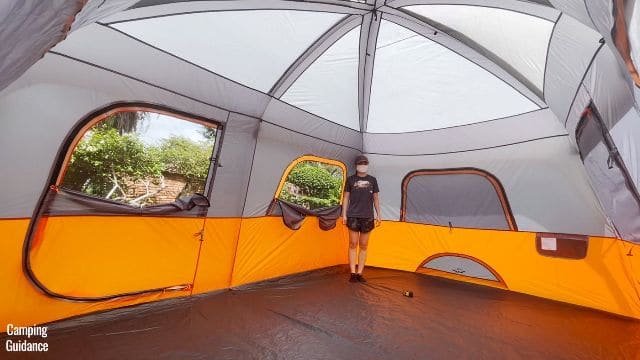
The problem here though is that if you’re not as tall though, like me, you’d have trouble reaching the gear loft and the lantern loop at the top. But hey, having too much space is a good problem to have right?

With its near vertical side walls, the Core 10-Person Cabin Tent is easily the tent with the most livable space for sure.

It also comes in a very nice color, not only in the day but at night too. The Core Tent is also great in light rain, and went through 1 hour of light rain with no leaks at all.
Overall, the Core 10-Person Straight Wall Cabin is a great all-rounder tent with no obvious flaws. But apart from spaciousness, compared to the rest of my other 10-person tents, the Core 10-Person Tent came in only about average for the rest of the tests (like ventilation, rain + more).
But if spaciousness is your priority, the Core 10-Person Straight Wall Cabin Tent is the perfect fit for you.
More info on the Core 10-Person:
6. Ozark Trail 10-Person Cabin Tent (Budget Pick)
Key Info
- Peak Height: 88 inches
- Length: 13 feet 9 inches
- Width: 9 feet 11 inches
- Base Area: 136.4 square feet
- Material: Polyethylene (Flooring), 68D Polyester (Tent and Rainfly), Steel and Fiberglass (Poles)
- Packed size: 29 by 18 by 13 inches
- Weight: 30.0 pounds
- Storage: 2 pockets, 1 lantern loop, 1 gear loft
- Ventilation: 5 windows, 1 door, ceiling mesh
- Other Features: Room divider (1), E-port (1)
- Set Up Timing: 10 minutes (2 people), 20 minutes (1 person)
- Take Down Timing: 6.5 minutes (2 people), 12 minutes (1 person)
Pros and Cons
Summary
If you’re on a tight budget and can’t afford to shell out more than ~$100 on a 10-person tent, the Ozark Trail 10-Person Cabin Tent is worth checking out. It is, by far, my least expensive tent for the size. And it even comes with a gear loft and room divider.

I paid slightly over $100 for the Ozark Trail 10-Person Tent that I tested in this review, but do take note of a few things.
The quality of Ozark Trail tents aren’t the best, and this Ozark tent was no different, with slightly sticky walls, loose threads, mesh runs, and door snagging.
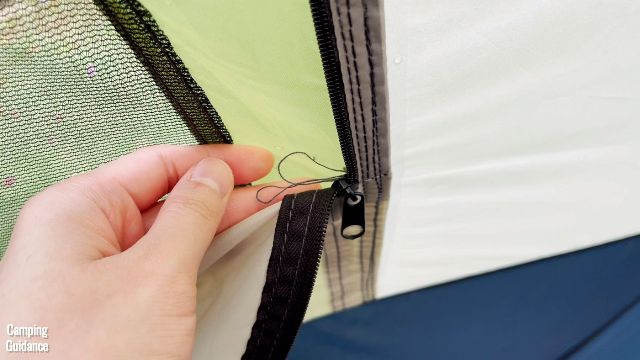
It also offers the least protection against rain, leaking within just 15 minutes of light rain, the least ventilation when raining, and has only a single door.
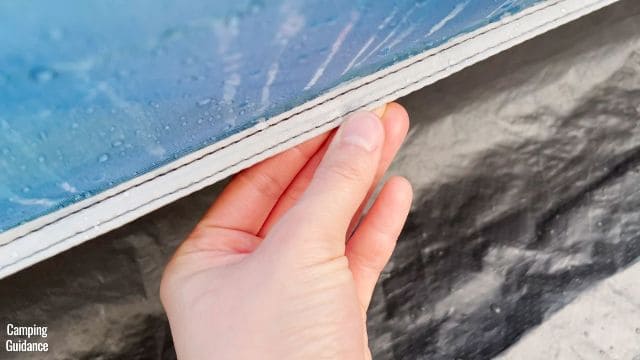
But other than that, you can certainly use the Ozark Trail 10-Person Cabin Tent on sunny days, and it’s super spacious with a nice high peak height of 88 inches. You can’t get any other brand of tent at this price, for sure.

More info on the Ozark Trail 10-Person Tent:
Recommendation Summary
Here’s a quick summary of all the 10-person tents that I bought and tested for this review:
- Best Value for Money: Coleman WeatherMaster 10-Person Tent
- Best Premium Tent: Columbia Mammoth Creek 10-Person Tent
- Best Instant Tent: Outdoor Products 10-Person Instant Tent
- Best Blackout Tent: Coleman 10-Person Instant Cabin Tent
- Most Spacious: Core 10-Person Straight Wall Cabin Tent
- Budget Pick: Ozark Trail 10-Person Cabin Tent
If you’d like to compare how each of the six best 10-person tents performed in each test, here’s a cool graphic where you can do so:

For more info on how I tested each 10-person tent, and came up with these scores, I’ll explain all of it in detail in the next section.
How I Tested My 10-Person Tents
I put each 10-person tent through 7 different tests:
- Ease of Use
- Spaciousness
- Comfort and Features
- Ventilation
- Weather Protection
- Quality
- Portability
At the end of all the tests, I compiled all the data and came to a decision in the Overall Performance Section.
Ease of Use
For ease of use, I looked at how easily I could set up, as well as take down and pack up, all of these 10-person tents.
Set Up (2-person)
When I set up each 10-person tent with my brother, here’s how long each tent took us to set up (in minutes), including staking and guying out the tents:
| 10P Tent | 2P Set Up Timing |
|---|---|
| Outdoor Products 10P | 6 minutes |
| Coleman Instant 10P | 7.5 minutes |
| WeatherMaster 10P | 10 minutes |
| Ozark Trail 10P | 10 minutes |
| Core 10P | 11 minutes |
| Columbia 10P | 14 minutes |
The 2 fastest 10-person tents were the Outdoor Products Instant Tent and the Coleman Instant Cabin Tent. They were both super user-friendly, especially the Outdoor Products tent.

The Coleman Instant Tent took slightly longer to set up mainly because of this extra step of installing these green-colored fiberglass poles for the hinged D-door, which takes about 1 minute for 2 people.

Of the 4 non-instant tents, I found the WeatherMaster 10-Person Tent to be the easiest to set up, mainly because there are only 3 roof poles to insert into these short and pretty much snag-free pole sleeves. And it’s color-coded too!
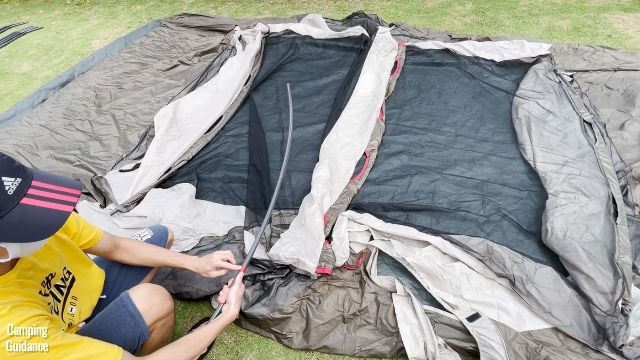
There are 6 of these straight poles for the walls, which is the same as all the other tents.

There are 4 fiberglass poles, 2 for the angled windows that you need to set up, and 2 for the hinged D-door.
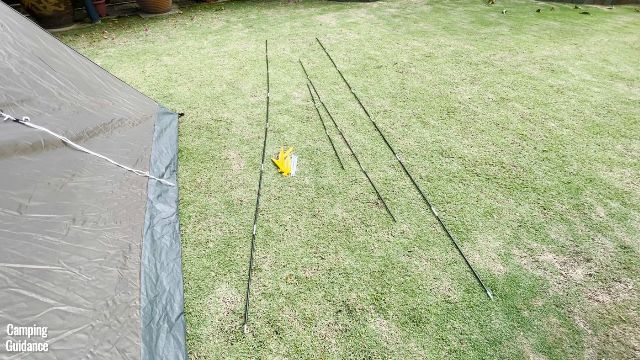
The next easiest tent to set up is the Ozark Trail 10-Person Tent, which also has 3 roof poles. But, the pole sleeves are a lot longer, and also the roof poles are not color-coded.
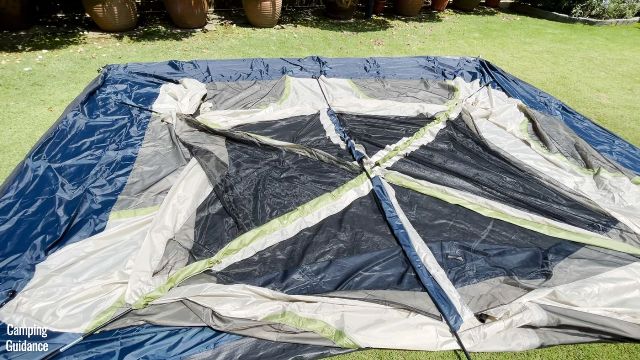
Like all the other tents, there are 6 steel poles for the walls. To stake and guy out the tent, there are 14 steel stakes.

The Core 10-Person Straight Wall Cabin Tent has almost the exact same design and set up as the Ozark Trail Tent, with 3 color-coded roof poles and 6 wall poles.
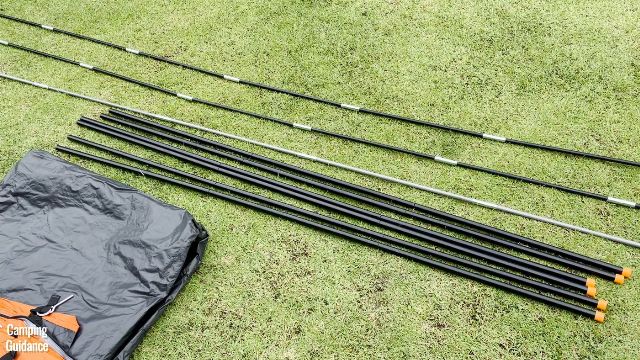
It took slightly longer to set up because it has 6 extra stakes for the ground vents and doors, so 20 stakes in total.
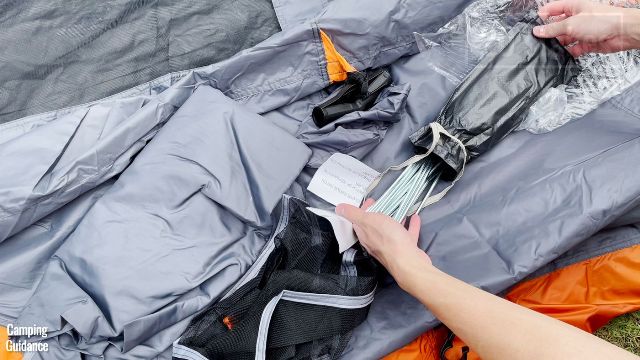
Lastly, we have the Columbia Mammoth Creek 10-Person Tent, with not 3, but 6 roof poles.

It also has 2 additional pole clips, 10 guylines, and 2 angled windows, which you need to set up from the inside of the tent.
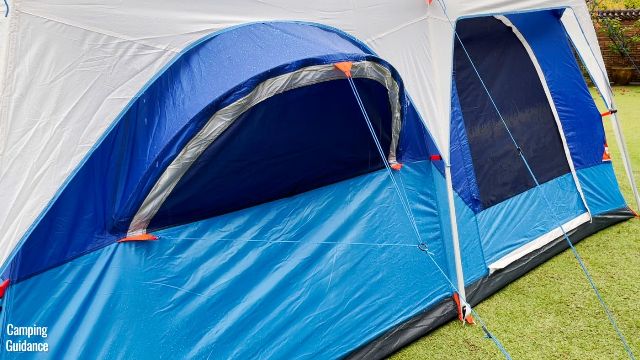
Set Up (1-Person)
I also tried my best to set each 10-person tent up on my own, and here are the timings:
| 10P Tent | 1P Set Up | 2P Set Up |
|---|---|---|
| Outdoor Products 10P | 12 mins | 6 mins |
| Coleman Instant 10P | 16 mins | 7.5 mins |
| WeatherMaster 10P | 19 mins | 10 mins |
| Ozark Trail 10P | 20 mins | 10 mins |
| Core 10P | 22 mins | 11 mins |
| Columbia 10P | 28 mins* | 14 mins |
The 1-person set up timing is roughly double the time of the 2-person timing, give or take. But here are a few things to take note of.
I’m about 5’3″ (~63 inches or 160 cm), so because of the high peak heights of these tents, I could not put the rainfly on for the Ozark, Core and Outdoor Products 10-Person Tents.

Also, for the Ozark, Core and Columbia 10-Person Tents, these tents come with these elbow or pole connectors, which I felt was a humongous pain to set up by myself.
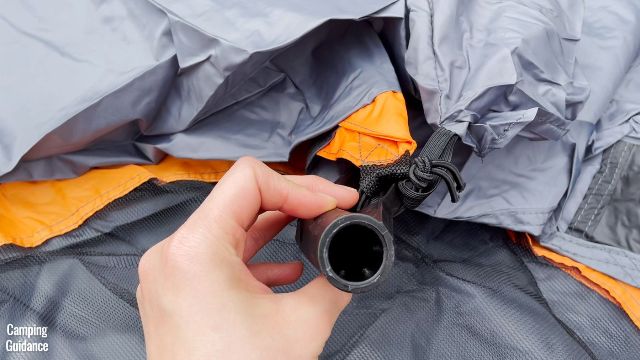
Because the roof of these tents are supposed to be propped up, it’s very difficult to get the poles to arch the correct way on your own.

Not impossible, because I’ve done it, but difficult. If the poles arch the wrong way, you’ll get an inverted roof, like this, which is super annoying.
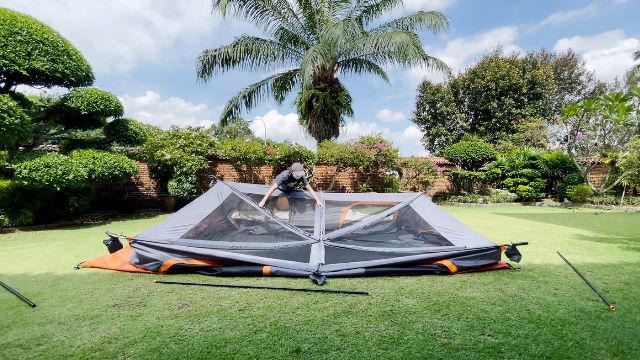
So, I highly recommend getting someone else to go inside the tent to set up it much more easily, and also so you won’t put too much stress on the fiberglass poles.
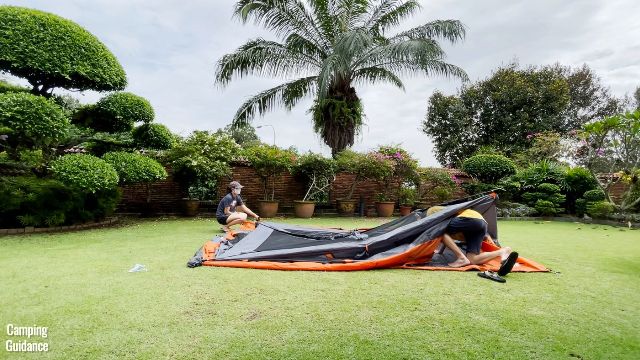
For the Columbia 10-Person Tent, I couldn’t even get the blue fiberglass roof poles into these pole connectors on my own, and almost broke my pole trying to.
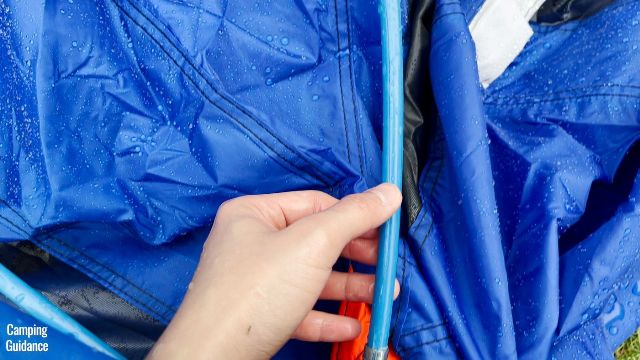
The bottom line is that the only 2 tents that I could put up on my own, is the Coleman Instant 10-Person Cabin Tent, and the Coleman WeatherMaster 10-Person Tent. If you’re a bit taller than me, the Outdoor Products 10-Person Instant Cabin Tent will be a breeze to put up as well.
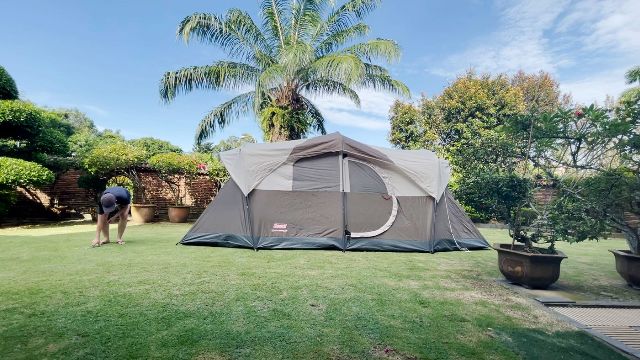
Ease of Take Down
For ease of take down, here are the timings starting from the fastest to take down and pack up:
| 10P Tent | 2P Take Down | 1P Take Down |
|---|---|---|
| Outdoor Products 10P | 4.25 mins | 8.5 mins |
| Coleman Instant 10P | 5 mins* | 10 mins* |
| Ozark Trail 10P | 6.5 mins | 12 mins |
| Core 10P | 7 mins | 13 mins |
| WeatherMaster 10P | 8.5 mins | 16 mins |
| Columbia 10P | 8.5 mins | 16 mins |
*I put an asterisk for the Coleman 10-Person Instant Cabin Tent, because it’s an estimated timing. I did take down the entire tent, but I did not pack it up into the carry bag, because there was a manufacturing defect, and it couldn’t fit back in.
But my Outdoor Products 10-Person Tent fit back in very easily, and is exactly the same size.


On top of that, this Coleman carry bag can be expanded by ripping the bottom of the bag off.

When I sent the Coleman tent back to Amazon, it wasn’t that difficult to fit everything back in, but I forgot to time it.
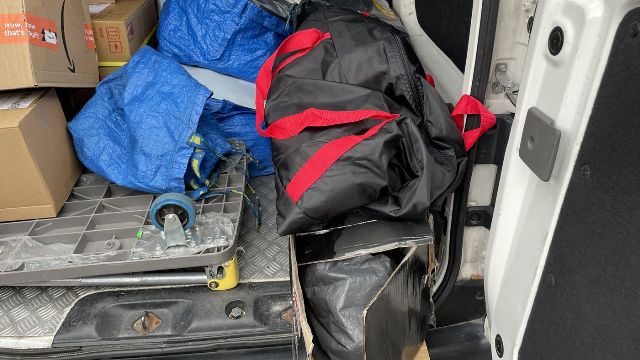
Also, the Coleman WeatherMaster 10-Person Tent took slightly longer than I expected because it was quite a tight fit to stuff everything back into the carry bag. It was a much tighter fit than the rest of my 10-person non-instant tents.
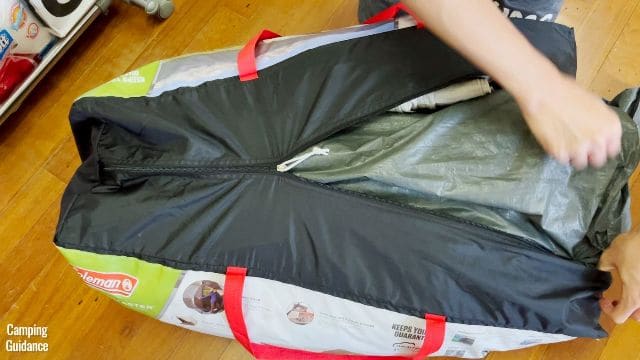
One last thing for this section – All these timings are based on me having set up and taken down each tent at least half a dozen times.
Ease of Use Ratings
So, based on the ease of set up and take down by not only 1 person, but 2 people as well, I rated the ease of use of each 10person tent (out of 10, with 10 being the easiest to set up).
Here are those ratings in chart form:
And also in table form:
| 10P Tent | Ease of Use Ratings |
|---|---|
| Outdoor Products 10P | 10.0 |
| Coleman Instant 10P | 9.0 |
| WeatherMaster 10P | 7.0 |
| Ozark Trail 10P | 7.0 |
| Core 10P | 7.0 |
| Columbia 10P | 5.0 |
Spaciousness
For spaciousness, I looked at the peak height, slope of the walls, and the base area of each 10-person tent in this review.
Peak Height
Here’s the peak height of each 10-person tent from the highest to lowest:
| 10P Tent | Peak Height |
|---|---|
| Core 10P | 90 inches |
| Ozark Trail 10P | 88 inches |
| WeatherMaster 10P | 80.5 inches |
| Columbia 10P | 80 inches |
| Outdoor Products 10P | 77.5 inches |
| Coleman Instant 10P | 73.5 inches |
If you were wondering why I could attach the rainfly of the Coleman 10-Person Instant Cabin Tent on my own without any help, it’s because the Coleman has a much lower peak height than the rest.

For my height of 5’3″ (~63 inches or 160 cm), to reach the loop at the very top of the tent (for attaching a lantern or room divider), the highest peak height that I could reach was the WeatherMaster Tent with 80 and a half inches. Even so, I had to really stretch my arm out and stand on tiptoes at the same time.

I couldn’t reach the top for the Core and Ozark Trail 10-Person Tents. This can be a bit problematic if you’re trying to install a gear loft, a lantern, or room divider:

Slope of Walls
5 out of 6 these 10-person tents are cabin tents with almost vertical side walls, with 2 exceptions.

First, the WeatherMaster 10-Person Tent isn’t a cabin tent, and it has this small triangular space here:

Here’s what it looks like from the inside:

That’s also why I could set up the rainfly of the WeatherMaster 10-Person Tent on my own without any help.
But excluding the small triangular space, the lowest height in the tent, which is about here at the corners of the tent, is about 58 inches.

Second, even though the Coleman 10-Person Instant Tent is supposed to be a cabin tent, I felt like there weren’t enough pole clips in this tent.

As such, the tent body felt a bit droopy, especially on this side of the tent.
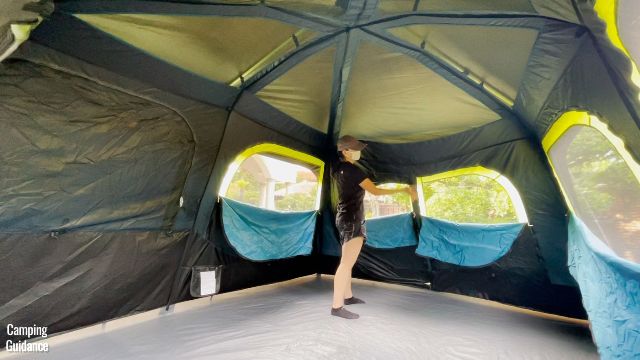
Also, the side walls aren’t as vertical as I expected them to be.

This reduces livable space a little bit for sure. The lowest height in the tent, also at the 4 corners, is about 59 inches.

The lowest height in the rest of the tents are a few inches higher.
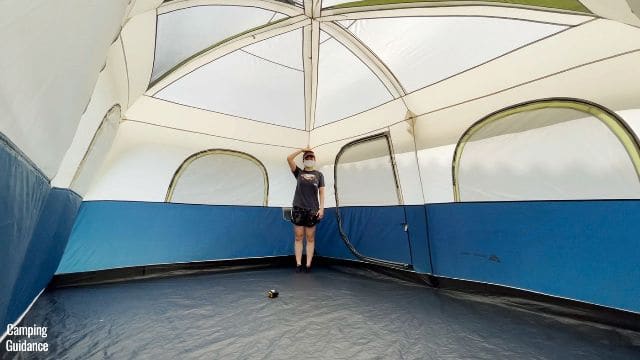
Here’s the lowest height in each 10-person tent, starting from the lowest to highest:
| 10P Tent | Lowest Height |
|---|---|
| WeatherMaster 10P | 58 inches |
| Coleman Instant 10P | 59 inches |
| Outdoor Products 10P | 61 inches |
| Columbia 10P | 62 inches |
| Ozark Trail 10P | 65 inches |
| Core 10P | 65 inches |
Base Area
I took the floor or base area measurements, both length and width (in feet), as well as the base area (in square feet):
| 10P Tent | Length | Width | Base Area |
|---|---|---|---|
| WeatherMaster 10P | 16.67 feet | 9.08 feet | 143.6 square feet |
| Columbia 10P | 13.92 feet | 9.92 feet | 138.0 square feet |
| Ozark Trail 10P | 13.75 feet | 9.92 feet | 136.4 square feet |
| Outdoor Products 10P | 13.58 feet | 10.0 feet | 135.8 square feet |
| Core 10P | 13.58 feet | 10.0 feet | 135.8 square feet |
| Coleman Instant 10P | 13.92 feet | 9.75 feet | 135.7 square feet |
There’s not a lot of difference in the base area of all 6 tents, but here are a few things to take note of.
Apart from the WeatherMaster 10-Person Tent, the rest of the 10-person tents all have marketed dimensions of 14 by 10 feet, but the measurements that I took were slightly smaller for all the tents.

These 5 tents (with base area dimensions of about ~14 by 10 feet) also have a rectangular base area:

Only the WeatherMaster 10-Person Tent does not have a rectangular base area:

So, that’s why the maximum number of queen-sized camping mattresses I could fit into this WeatherMaster 10-Person Tent was only 3.

The mattresses that I used in this picture are slightly smaller, but almost queen size (give or take a few inches). Apart from these 3 mattresses, there’s quite a bit of space leftover for camping gear (the space to where I’m pointing at in the picture).
As for the other 10-person tents with rectangular floor space, they could all fit 4 queen-sized mattresses.
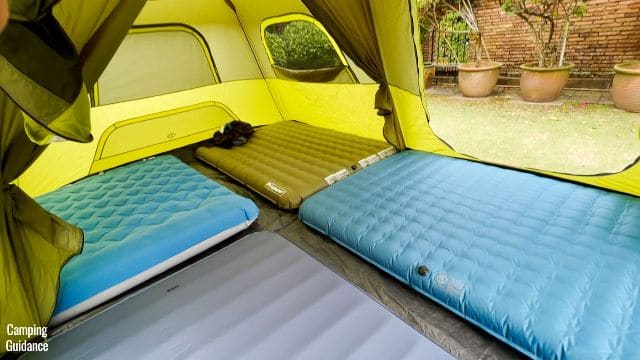
However, the problem here is that there’s hardly any space leftover for camping gear, as you can see here.

If you’re wondering, every single one of these tents can accommodate 10 single sleeping pads or sleeping bags, but that means you’ve got to sleep practically shoulder to shoulder.

Plus, you’d have a tiny bit of space for camping gear, especially in the WeatherMaster tent, because it has the biggest base area.
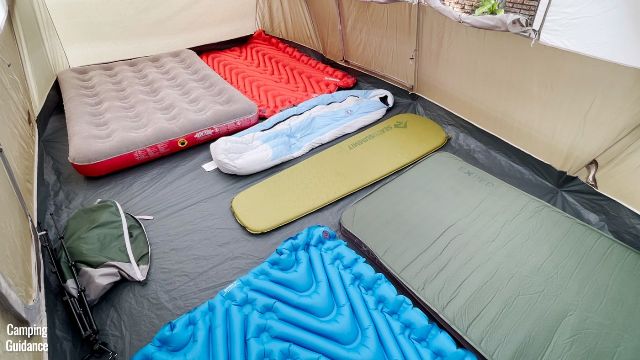
Also, none of these tents have vestibules, so if you leave your shoes out, it will get wet if it rains.
Spaciousness Ratings
So, based on the peak height, lowest height, slope of the walls, and the base area, I rated the spaciousness of each 10-person tent (out of 10, with 10 being the most spacious).
Here are those ratings in chart form:
And also in table form:
| 10P Tent | Spaciousness Rating |
|---|---|
| Core 10P | 9.7 |
| Ozark Trail 10P | 9.7 |
| Columbia 10P | 9.3 |
| Outdoor Products 10P | 9.0 |
| WeatherMaster 10P | 9.0 |
| Coleman Instant 10P | 7.7 |
Comfort and Features
For comfort and features, I’m going to focus on the doors, room divider, storage options, and dark room technology.
Doors
Here’s the number of doors that each 10-person tent has, from the most to the least:
| 10P Tent | Number of Doors |
|---|---|
| Outdoor Products 10P | 3 |
| WeatherMaster 10P | 2 |
| Coleman Instant 10P | 2 |
| Columbia 10P | 2 |
| Core 10P | 2 |
| Ozark Trail 10P | 1 |
Most of the doors are anywhere between 58 to 65 inches from the floor to the top of the door, so even at my height, I do need to duck a little bit to get through all the doors.

Take note that the hinged D-door of the Coleman 10-Person Instant Tent is only about 47 inches from the ground to the top of the door, so I had to duck even more.
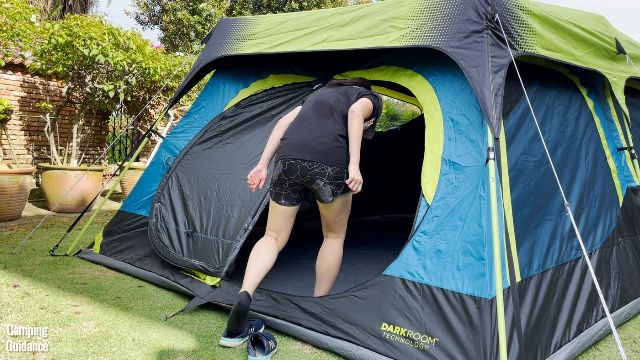
The Outdoor Products 10-Person Tent has 3 doors. One is this huge T-door, which measures about 72 by 51 inches.

To the left and right of the T-door, we have the other 2 smaller side doors, both measuring about 55 by 47 inches.

The WeatherMaster 10-Person Tent has 2 doors, one at each length of the tent. The front door is this super user-friendly hinged D-door, measuring about 47 by 30 inches in dimensions.

The back door on the back length of the WeatherMaster 10-Person Tent, which measures about 57 by 34 inches, is not hinged, so you do have to zip it open and close.

The Coleman 10-Person Instant Tent also has 2 doors, one at each width of the tent. The door on the left width is this hinged D-door, measuring about 50 by 34 inches in dimensions:

The other door on the right width of the tent is not hinged, and measures about 47 by 46 inches.
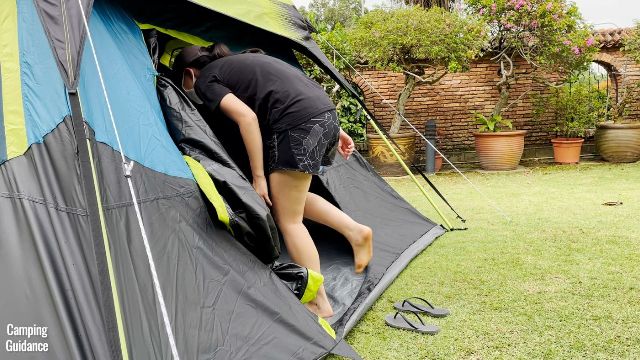
The Columbia 10-Person Tent has one humongous T-door, measuring about 91 by 55 inches:

Right beside it, we have this smaller side door, which is about 47 by 55 inches in dimensions:

The Core 10-Person Tent has 2 identical D-shaped doors, each measuring 53 by 38 inches in dimensions. One is at the front length, and the other is at the back length of the tent.
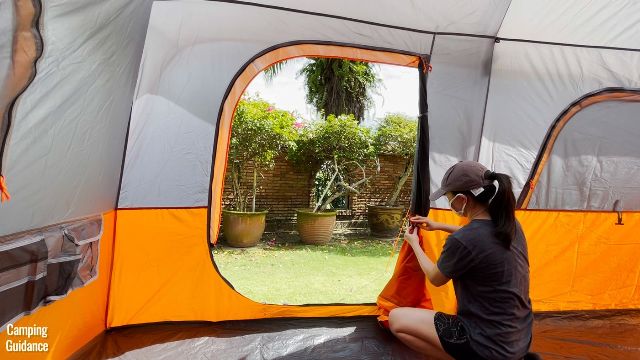
And lastly, the Ozark Trail 10-Person Tent has only 1 D-shaped door, which measures about 54 by 39 inches in dimensions.
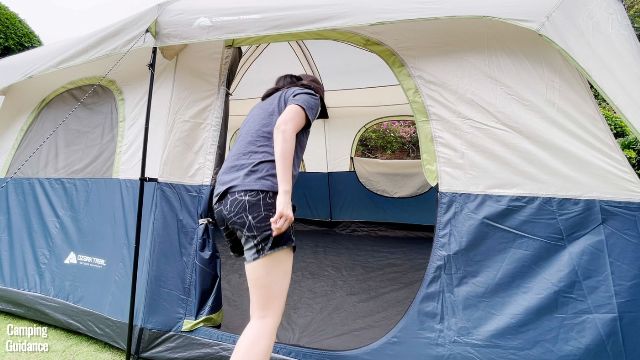
Having just 1 door in a 10-person tent is especially inconvenient, because that means climbing over your tent mates just to get out of the tent.
Room Divider
All of these 10-person tents come with room dividers, but the best one goes to the Columbia 10-Person Tent, which is pre-attached and cannot be removed, though you can pull back the sides of the divider if you don’t want to use it.

What I really like about this pre-attached divider is that it’s completely full length, so there are no gaps at the top, bottom, or sides, and it’s also not very see-through.
My only issue is that both doors are on the same side of the divider.
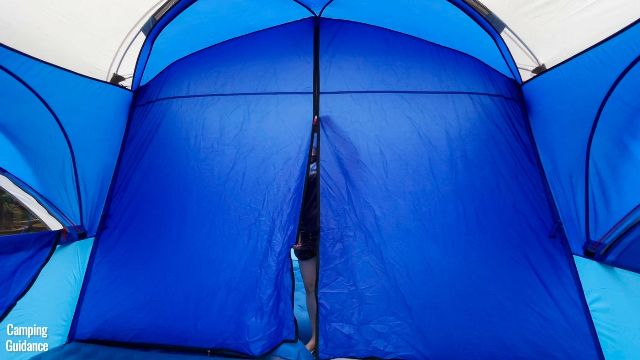
The room divider of the Outdoor Products 10-Person Tent is similar to the Columbia’s, except for the color.
It does have the same issue though – all 3 doors are on the same side of the divider.

As for the rest of the tents, I’m not really a big fan of the room dividers. Let me explain why.
The removable room divider of the WeatherMaster 10-Person Tent has pretty big gaps at the sides, top, and bottom of the divider.
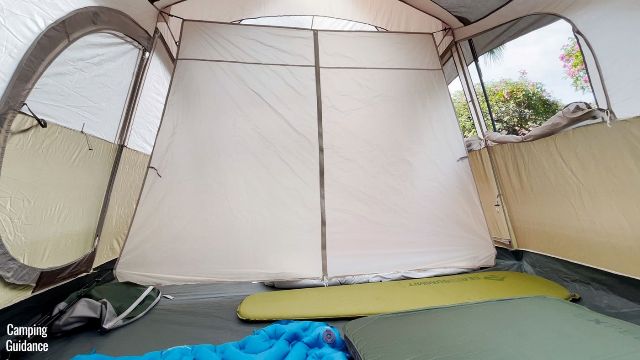
The removable room divider of the Coleman 10-Person Instant Tent also has big gaps at the sides, and you actually see quite a bit through it.
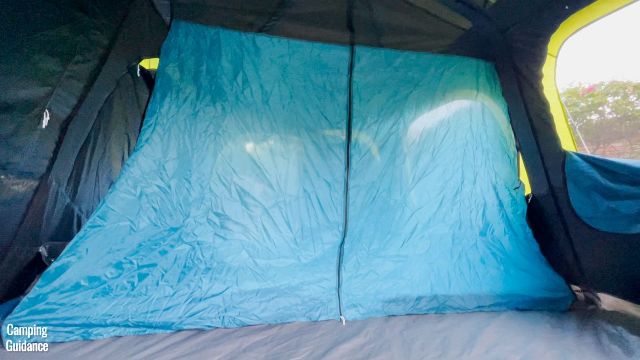
Same with the Core 10-Person tent divider, where you can see almost the entire room through the divider.

And the Ozark Trail 10-Person Tent’s room divider has huge gaps at the sides, top, and bottom, plus there’s no zip down the middle for easy access.
This means that when you want to access the other room, you’ve got to take down the divider and then put it back up again.
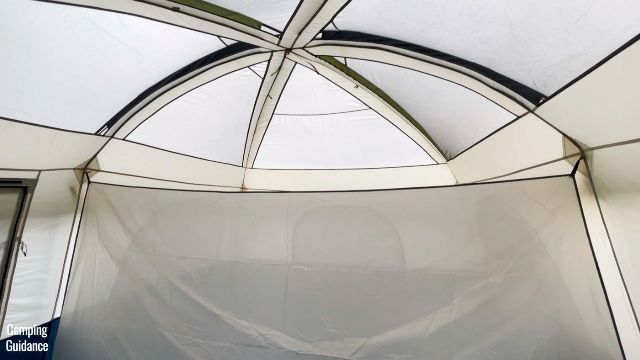
Storage
Here’s a quick summary of the storage options in each 10-person tent, from the most to least:
| 10P Tent | Pockets | Gear Lofts | Loops |
|---|---|---|---|
| Outdoor Products 10P | 2 | 0 | 4 |
| WeatherMaster 10P | 4 | 0 | 1 |
| Core 10P | 2 | 1 | 1 |
| Ozark Trail 10P | 2 | 1 | 1 |
| Columbia 10P | 2 | 0 | 2 |
| Coleman Instant 10P | 2 | 0 | 1 |
The Outdoor Products 10-Person Tent has only 2 pockets, but they’re the biggest of all these 10-person tents, with each pocket measuring 47 by 7 inches.

Also, the Outdoor Products 10-Person Tent has a whopping 4 lantern loops.

The WeatherMaster 10-Person Tent has 4 pockets, 2 on each width of the tent. Each of the pockets come in this triangular shape, measuring about 20 inches (longest length) by 10 inches (height):

The WeatherMaster 10-Person Tent also has 1 lantern loop:

The Core 10-Person Tent has only 2 pockets, with the bigger one measuring 10 by 19 inches, and the smaller one measuring 14.5 by 7 inches.
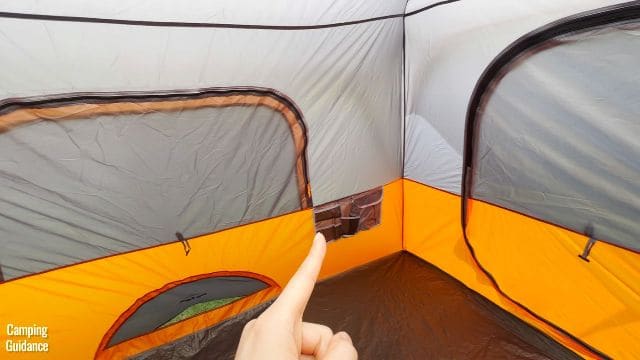
But the Core 10-Person Tent comes with a small gear loft as well. You can use the divider at the same time, and there’s 1 lantern loop too.


The Ozark Trail 10-Person Tent also has 2 pockets, each measuring 13 by 6 inches.

Similar to the Core Tent, the Ozark Tent also comes with a gear loft, and 1 lantern loop.
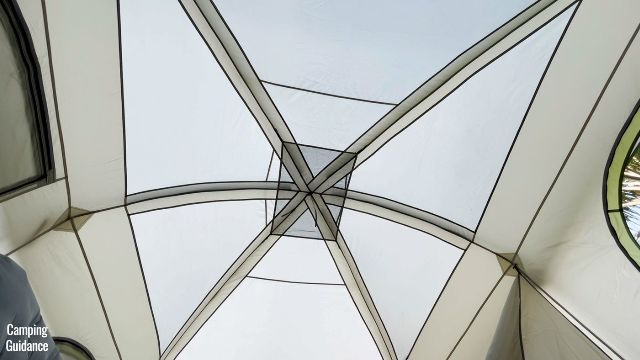

The Columbia 10-Person Tent has only 2 pockets (each pocket measuring 15 by 8 inches), and 2 lantern loops (one on each side of the divider).

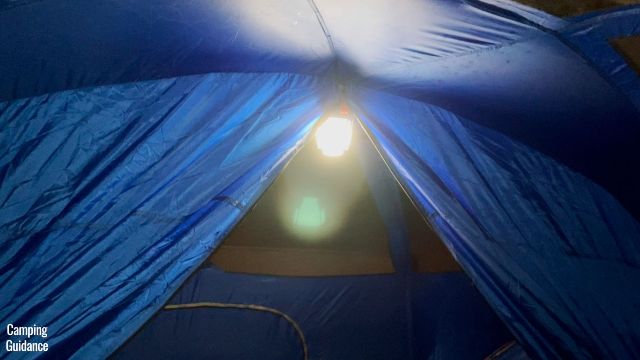
And lastly, the Coleman 10-Person Instant Tent has 2 tiny pockets (7 by 8 inches), and 1 lantern loop.
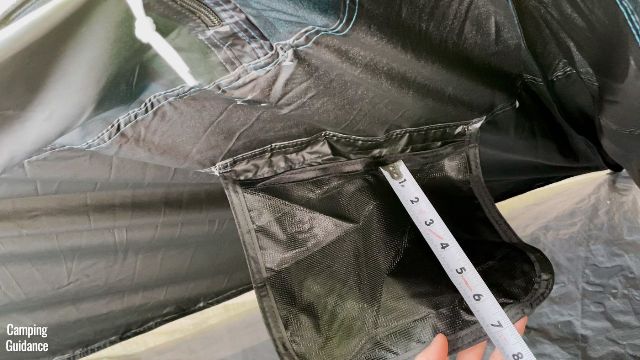

Blackout Feature
As for the blackout feature, special mention has to go to the Coleman 10-Person Dark Room Instant Cabin Tent, which is the only 10-person tent in this review with this feature.
This is what the Coleman Instant Dark Room tent looks like when all the windows are closed in the middle of the day.

There’s only a little bit of light seeping in through the gap between the roof and the rainfly, and also from the bathtub flooring at the bottom of the tent. It’s perfect for sleeping in, really.
And if you’re the type that doesn’t like a single spot of light when you’re sleeping at night, check out how dark this tent is at night, it’s seriously quite amazing.

It’s almost pitch black even though there are still street lights from the outside.
The dark room feature also makes the Coleman tent quite a bit cooler inside the tent during the day, compared to my other tents in this review.
Comfort Ratings
So, based on the doors, room divider, storage options, and blackout features, I rated the comfort levels and features of each 10-person tent (out of 10, with 10 being the most comfortable).
Here are those ratings in chart form:
And also in table form:
| 10P Tent | Comfort Ratings |
|---|---|
| Outdoor Products 10P | 9.3 |
| Columbia 10P | 8.3 |
| Coleman Instant 10P | 8.3 |
| WeatherMaster 10P | 8.0 |
| Core 10P | 7.0 |
| Ozark Trail 10P | 5.3 |
Ventilation
For ventilation, I looked at the ceiling mesh, vents, windows, and rainy day options.
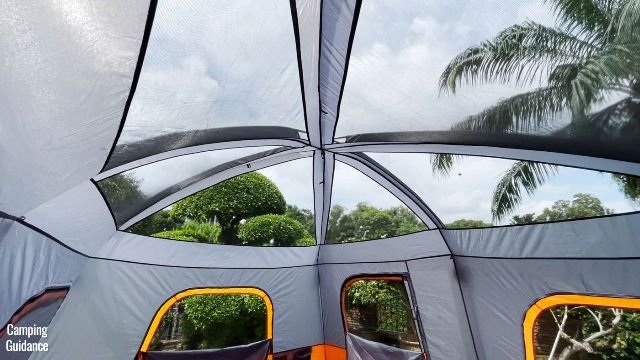
Ceiling Mesh
All of the 10-person tents in this review have a lot of ceiling mesh, so on a hot day, you can take the rainfly off from the outside for more ventilation.

You also can watch the sunset from inside your tent, and stargaze at night if it’s not raining.

Vents
Here’s the number of vents that I found in each 10-person tent. All of these are ground vents:
| 10P Tent | Vents |
|---|---|
| Core 10P | 2 |
| Outdoor Products 10P | 1 |
| Columbia 10P | 1 |
| WeatherMaster 10P | 0 |
| Coleman Instant 10P | 0 |
| Ozark Trail 10P | 0 |
Although the Outdoor Products 10-Person Tent has only 1 vent, it’s extra-large and measures about 59 inches in length and 11 inches in width.

The Core 10-Person Cabin Tent is the only tent with 2 ground vents, both measuring about 32 by 9 inches each.
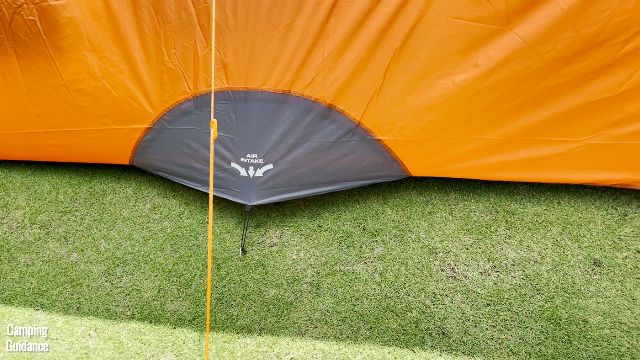
And lastly, the Columbia Mammoth Creek 10-Person Tent has 1 ground vent measuring 40 by 12 inches.
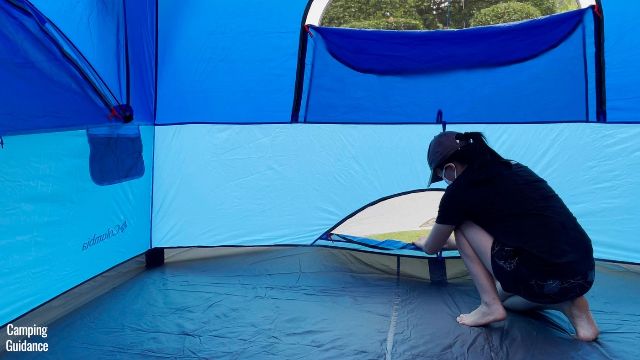
The rest of these 10-person tents (Coleman Instant, WeatherMaster, and Ozark) don’t have any vents at all.
Windows
Here’s the number of windows that can be opened from the inside for more ventilation, if it’s not raining. This also includes the mesh paneling from the doors:
| 10P Tent | Window Mesh | Door Mesh | Total |
|---|---|---|---|
| Coleman Instant 10P | 5 | 2 | 7 |
| Columbia 10P | 4 | 3 | 7 |
| Outdoor Products 10P | 3 | 4 | 7 |
| WeatherMaster 10P | 4 | 2 | 6 |
| Core 10P | 4 | 2 | 6 |
| Ozark Trail 10P | 5 | 1 | 6 |
So, after opening all the doors and window mesh, I measured the longest length and longest width of each one of them, and calculated the amount of ventilation in square inches.
The Coleman 10-Person Instant Cabin Tent has the most ventilation when it’s not raining, with a whopping 5 windows and 2 doors, almost all of them are massive, and it has an incredible ~9,400 square inches of ventilation.


Next up, we have the Columbia Mammoth Creek 10-Person Cabin Tent, with 4 windows and 3 door mesh panels, for a total ~7,800 square inches of ventilation.
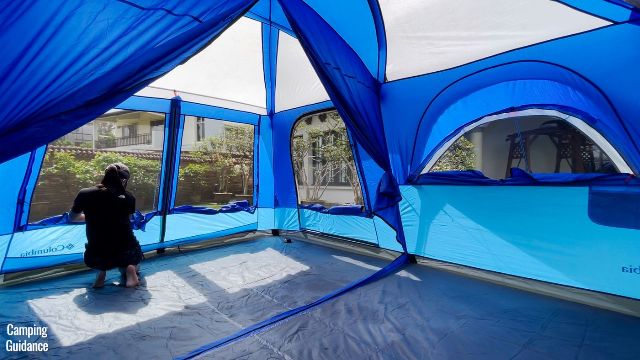
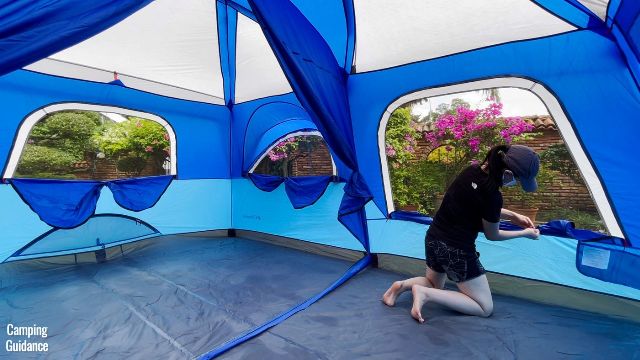
Tied for third place we have both the Outdoor Products 10-Person Cabin Tent and the Core 10-Person Cabin Tent, both with about ~5,900 square inches of ventilation.
The Outdoor Products 10-Person Tent has 3 smaller identical windows on the left side of the tent, plus 4 mesh panels from its 3 doors on the right side of the tent, which are pretty big.


The Core Tent has 4 identical windows, plus 2 doors, so 6 mesh panels in total.
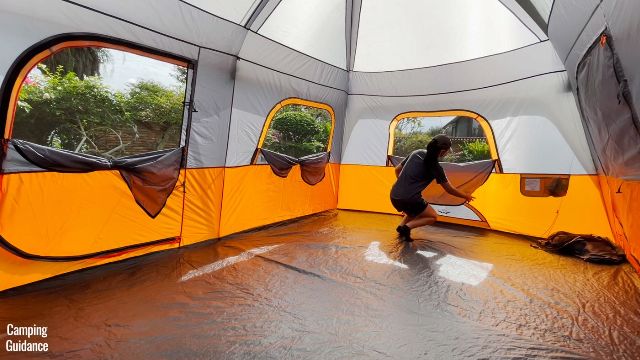
And lastly, in fourth place, we have both the WeatherMaster 10-Person Tent and the Ozark Trail 10-Person Cabin Tent, both with about ~5,500 square inches of ventilation.
The WeatherMaster Tent has 4 windows and 2 door mesh panels. 4 of them are not very big, but the 2 angled windows are pretty big.

The Ozark Trail Tent has 5 identical windows, and 1 door.
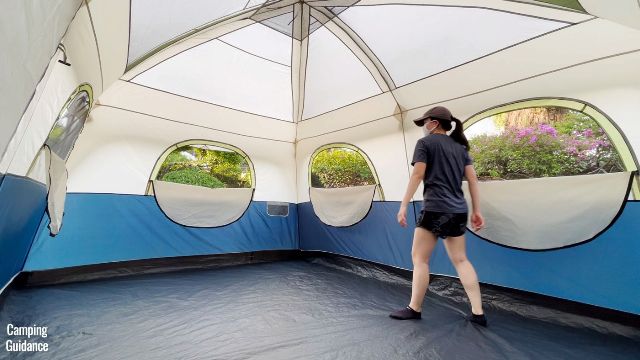
Rainy Day Options
The problem with these windows is that most of them cannot be opened when it’s raining out. This is because all 6 of these 10-person tents have rainflies that provide only partial coverage, like so:

As such, quite a bit of rain gets onto the mesh of the windows and doors, and will drip right into your tent if you don’t close them.

So, when it’s raining, the Columbia Mammoth Creek 10-Person Tent actually has the most ventilation.
Not only does it have 1 ground vent, it also has 2 pretty large pull-out windows (1 on each length of the Columbia tent), which I was able to leave open not only in light rain, but in moderate to heavy rain as well.
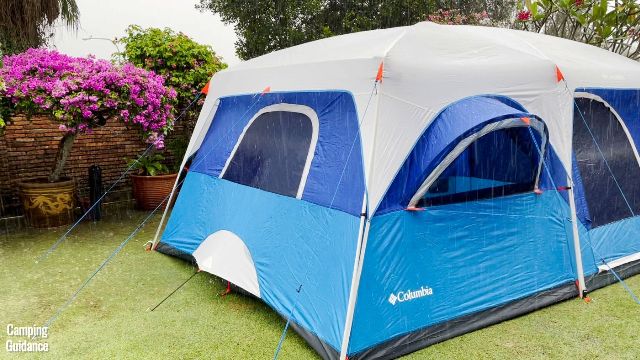
Next up, we have the WeatherMaster 10-Person Tent, with 2 angled windows (1 on each width of the tent) that are slightly larger than the Columbia’s, but with no vents. I was also able to leave these windows open in moderate to heavy rain.

Although the rest of the 10-person tents don’t have these cool angled window features, the Outdoor Products 10-Person Tent still has some ventilation from its extra-large vent.

The Core 10-Person Cabin Tent also has some ventilation with its 2 smaller ground vents (1 on each width of the tent).
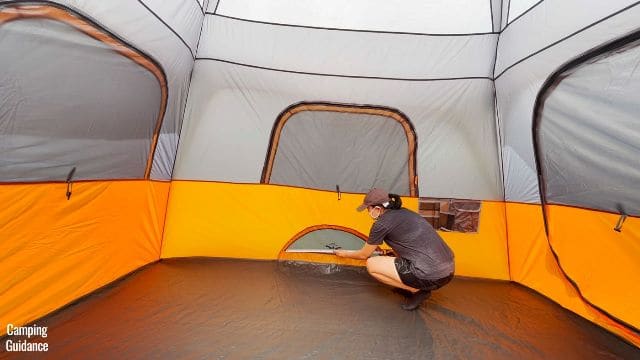
The only 2 tents with hardly any ventilation is the Coleman 10-Person Instant Tent and the Ozark Trail 10-Person Tent.
They have no angled windows, no vents, and the only ventilation that I got was through the gap between the ceiling mesh and the rainfly.
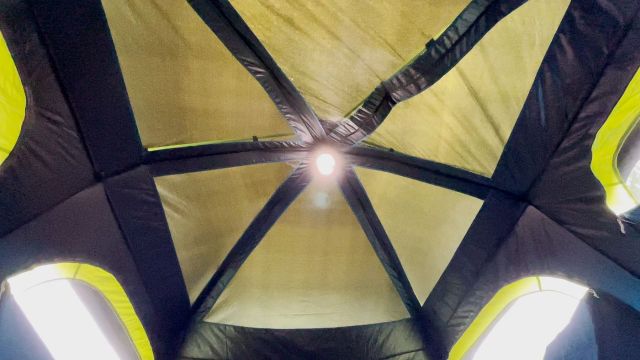
Ventilation Ratings
So, based on the ceiling mesh, vents, total square inches of mesh paneling around each 10-person tent (for hot days), as well as ventilation during rainy days, I rated the ventilation of each 10-person tent (out of 10, with 10 being the most ventilated).
Here are those ratings in chart form:
And also in table form:
| 10P Tent | Ventilation Ratings |
|---|---|
| Columbia 10P | 9.5 |
| Coleman Instant 10P | 7.5 |
| WeatherMaster 10P | 7.5 |
| Outdoor Products 10P | 7.0 |
| Core 10P | 7.0 |
| Ozark Trail 10P | 5.5 |
Weather Protection
For weather protection, I looked at rain and wind resistance.
Rain Test
Heavy Rain Test
I rain tested each of these 10-person tents, by putting them through at least an hour of rainfall each. It did not rain while I was testing and filming some of the tents, so I made my own rain with this water hose.
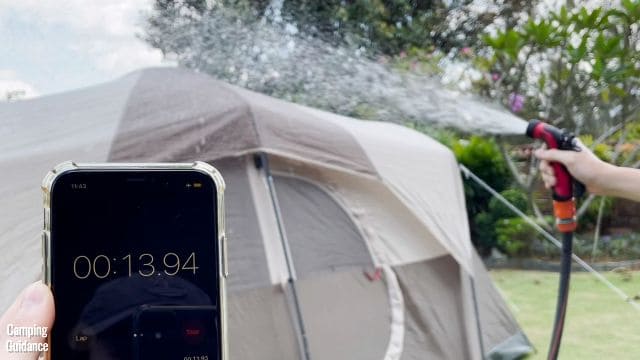
The best tent I have against rain is the Columbia Mammoth Creek 10-Person Tent. After an hour of moderate to heavy rain, I noticed no leaks at all, and all the fabric was still bone dry.

Take note that the Columbia Mammoth Creek was my only tent to pass the 1-hour rain test with no leaks at all, because it was my only 10-person tent that came with all its seams taped:
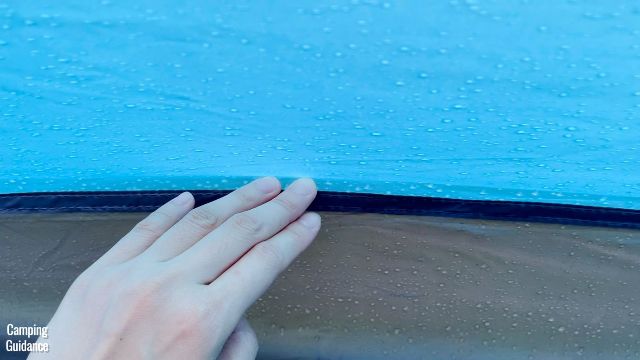
But after an entire night of raining, I noticed some leaking through the corners the next morning.
For the Outdoor Products 10-Person Tent, I used a water hose to rain test it, and noticed some leaking through the untaped seam (which connects the tent body to the bathtub flooring) after 15 minutes of pretty heavy rainfall.


After the 1-hour rain test though, apart from the seam leaking, none of the tent body or bathtub flooring of the Outdoor Products Tent was wet.
I also used a water hose with the Core 10-Person Tent, and noticed leaking through one of the doors’ zip and zippers at about 15 minutes in.

Tip: Moving the zippers to the top of the door, instead of placing them at the bottom of the door (like I did in the picture above) will greatly reduce the leaking.
After about 55 minutes of pretty heavy rainfall, the untaped seam connecting the orange tent body to the flooring also started leaking.
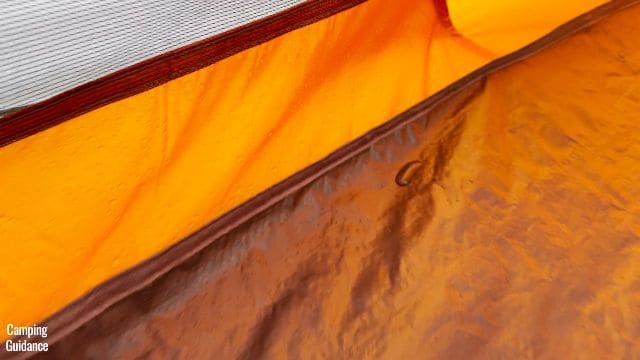
On top of that, the orange fabric near the ground vent felt a bit damp.
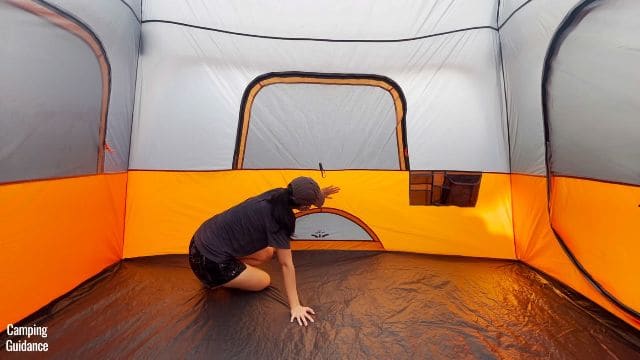
For the WeatherMaster 10-Person Tent, after about 15 minutes of pretty heavy rain, I noticed water started leaking into the tent through this inverted but untaped seam. This seam connects the dark brown fabric of the WeatherMaster tent body to the bathtub flooring.

Also, after the 1-hour rain test, the darker brown fabric was slightly damp.
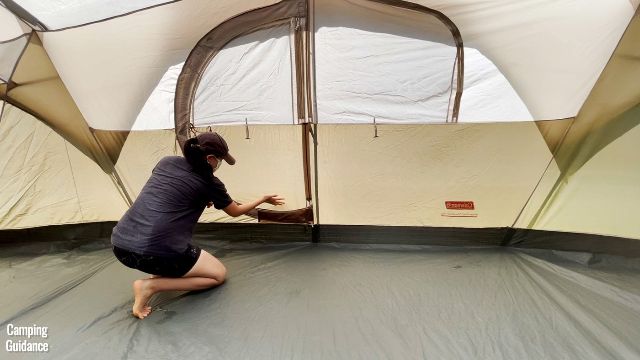
There was quite a few hours of light rain when I was using the Coleman 10-Person Instant Cabin Tent, and after about 15 to 30 minutes, I noticed that water started seeping in through this inverted but untaped seam, which connects the black tent body to the bathtub flooring.

Also, the zip and zippers of the hinged D-door also started leaking.

I was shocked to find that this yellow rain cover, which was supposed to be protecting the zippers from the rain, was completely soaked with water. I suspect that this made the leaking worse.
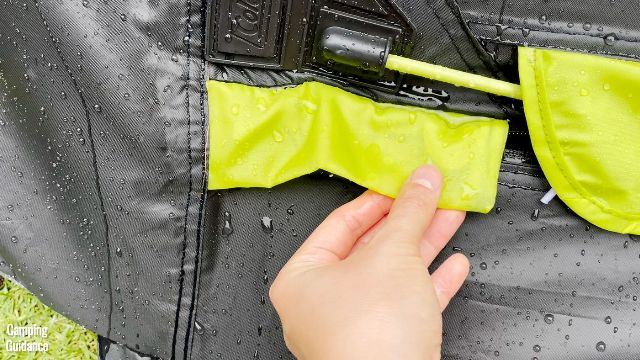
Similar to the Core tent tip above, I highly recommend placing the zippers at the top of the door, instead of the bottom, like I did.
And my least water resistant tent was the Ozark Trail 10-Person Tent, because after just 15 minutes of mostly light rain and some moderate rainfall, I started to see some leaking through this seam (connecting the blue tent body to the bathtub flooring), which is not taped.
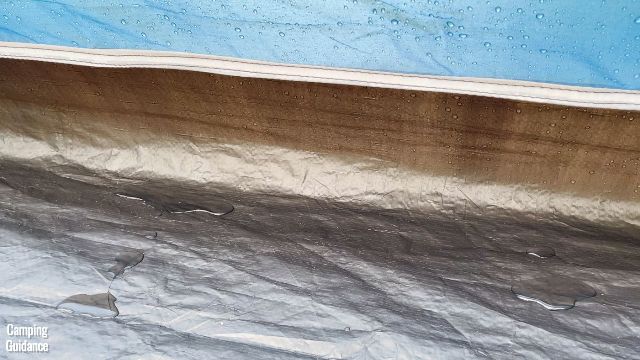
Also, I noticed that some water was already seeping in through the blue fabric near the bottom of the Ozark Trail tent. After just 15 minutes of light rain!
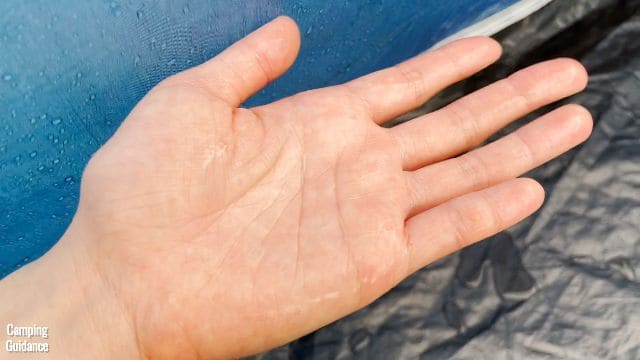
Light Rain Test
In light rainfall, the Columbia Mammoth Creek, Outdoor Products and Core 10-Person Tents did well, with no leaking seams or wet fabric.
The WeatherMaster and Coleman Instant 10-Person Tents had a tiny bit of leaking through the untaped seam, but the fabric was dry.
Wind Protection
I didn’t specifically test for wind protection, but I did notice a few things when wind was blowing through my 10-person tents.
Light Wind
Because most of these tents are cabin-shaped tents, if you don’t stake them down, they don’t stand a chance even against light wind.

If you stake them down, they’ll do okay in light wind.
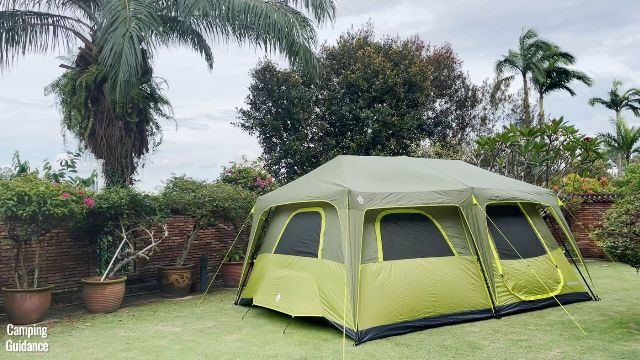
Stronger Wind
For stronger winds, those with more guylines, like the Columbia Mammoth Creek 10-Person Tent with the most number of guylines, which is 10, will do better than those with less guylines.

Those with more aerodynamic shapes, like the WeatherMaster 10-Person Tent, will do slightly better as well.

Even so, bear in mind that the WeatherMaster 10-Person Tent has vertical side walls on the front and back length of the tent, so it’s closer to a cabin-shape than a dome-shape.

Even for my Columbia Mammoth Creek Tent (which is my most water-resistant tent!), after a particularly stormy night, I noticed that one of the fiberglass poles for the roof bent and the tent partially collapsed.
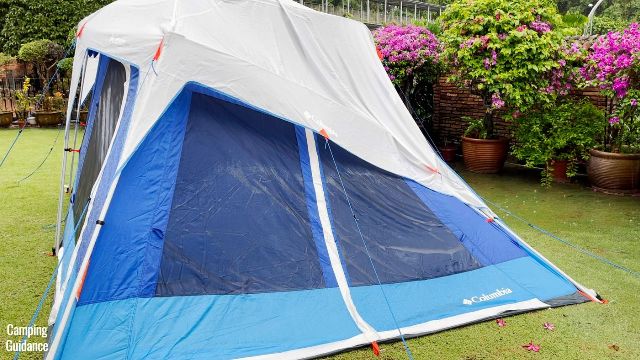
Thankfully, the pole wasn’t permanently bent, and I was able to pull it back into shape.
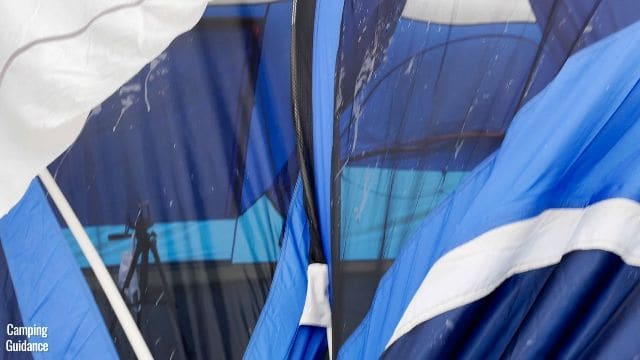
Basically, bottom line is that if you’re expecting very strong winds, I wouldn’t recommend any of these tents, because all of them have vertical side walls that can pick up a lot of wind, plus high peak heights.

Rain Test Ratings
So, based on the rain test only, I rated the rain protection of each 10-person tent (out of 10, with 10 being the most water resistant).
Here are those ratings in chart form:
And also in table form:
| 10P Tent | Rain Test Ratings |
|---|---|
| Columbia 10P | 9.0 |
| Outdoor Products 10P | 8.0 |
| Core 10P | 7.0 |
| WeatherMaster 10P | 7.0 |
| Coleman Instant 10P | 7.0 |
| Ozark Trail 10P | 5.0 |
Quality
For quality, I looked at the flooring, tent body, stitching, zippers, and more. Here are a few important things that I usually take note of.
Denier Rating
Most of the 10-person tents in this review have flooring made of polyethylene and tent bodies made of polyester, so the main differentiating factor was the Denier rating. Generally, the higher the Denier rating, the more durable and higher quality the material.
Check out the high quality materials that the Columbia Mammoth Creek tent is made of:
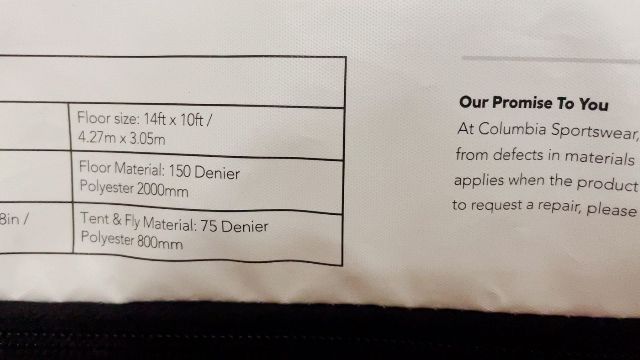
Also, I prefer that brands fully disclose the Denier ratings of their materials, just like Columbia did.
Stitching
I also check that the stitching all around the tent is consistent, and don’t make excessively large holes in the tent body. Here’s what good stitching looks like:

On the other hand, you get poor stitching when the brand can’t even sew in straight lines, there are humongous holes, and you get loose threads all over the tent.
Zipper Quality
For zipper quality, I like to make sure that the zippers have minimal to no snagging and leaking issues. Also, the higher quality zippers (like YKK and SBS) generally feel smoother and are less noisy.
Mesh Quality
There are 2 types of mesh that you will see in this review – no-see-um mesh and regular bug nets. No-see-um mesh keeps out even the smallest of insects, feel soft and silky to the touch, and is higher quality and more expensive.

Now, let’s go through the quality of each 10-person tent starting from the best.
Columbia 10P Tent
The Columbia 10-Person Tent body is made of 75D polyester, and the flooring is made of 150D polyester, which is much less crunchy and feels higher quality than my other 10-person tents.
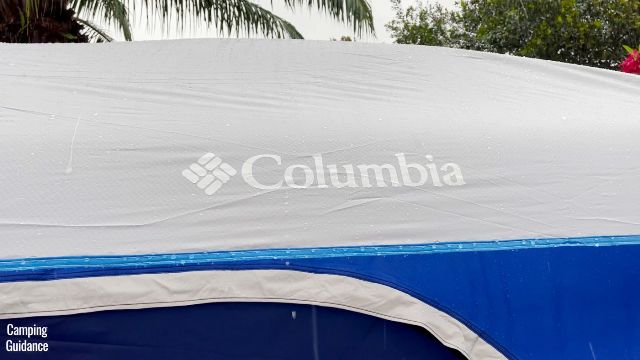
The stitching all around the tent is good, the zippers are SBS with no snagging issues, and the mesh is no-see-um, smooth and silky.
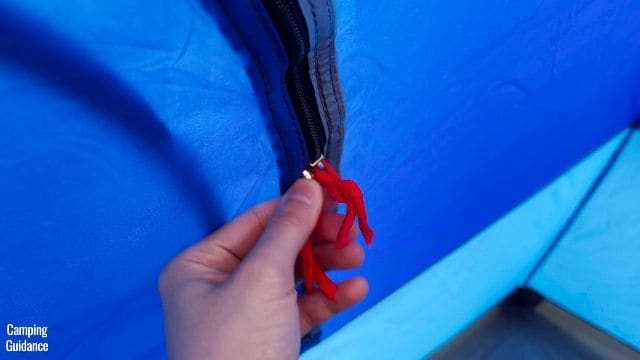
And the Columbia is my only tent that had all its seams taped.
Outdoor Products 10P Tent
The Outdoor Products 10-Person Tent has polyethylene flooring, while the main tent body and rainfly are made of 68D polyester.

The stitching is good, and the mesh is no-see-um and silky.

However, the zippers do snag on the side doors because of the rain cover (so that’s a minor design flaw).

WeatherMaster 10P Tent
The WeatherMaster 10-Person Tent has polyethylene flooring, the main tent body is made of 68D polyester, but the rainfly is made of 75D polyester taffeta.

All the seams in the WeatherMaster Tent are inverted, and the stitching is good all around the tent.
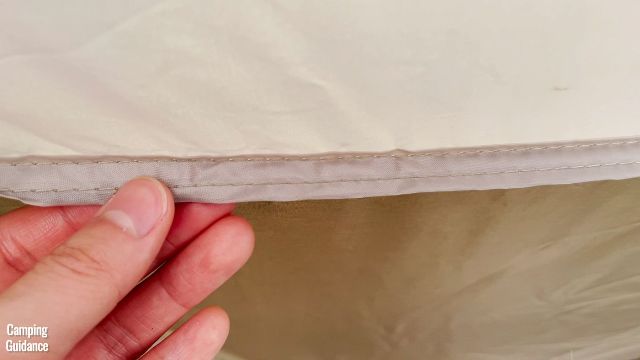
The mesh is good quality (though not no-see-um), and the zippers were pretty good quality as well, except for the occasional snag from the outside when using the back door that doesn’t have the hinged feature.

Core 10P Tent
The flooring of the Core 10-Person Tent is made of polyethylene, and the tent body is made of 68D polyester.
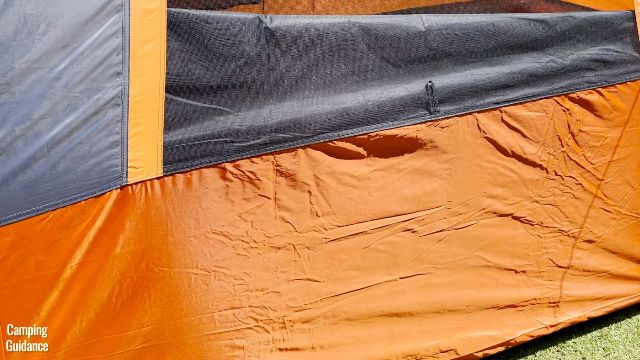
The stitching was fine, and the zippers were also okay except for the snagging on the door. It was a bit more snaggy than the WeatherMaster tent.
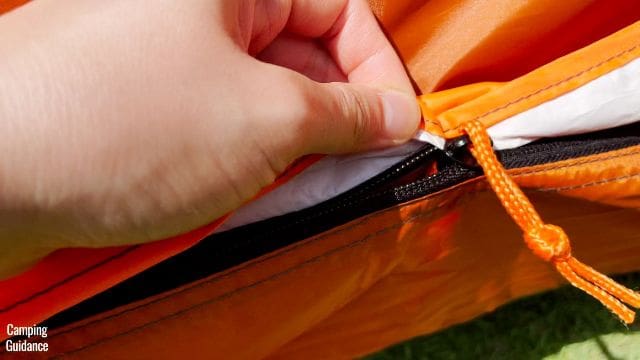
Also, my zip on one of the doors leaked during the rain, but the other one was fine.
Coleman Instant 10P Tent
I had no issues with the Coleman Instant Tent’s polyethylene flooring and polyester tent body (although I didn’t know the Denier rating), and the stitching was fine.

What I did not like though, was first, some of the seam tape wasn’t very well applied around the windows, so it blocks the zipper and makes it more snaggy.

Also, I found a couple of small holes in the mesh. (It might be clearer in the video I uploaded than the picture below.)

And lastly, my tent came with a defective pole that was attached the wrong way, but I guess manufacturing defects do happen.
Ozark Trail 10P Tent
The flooring of the Ozark Trail 10-Person Tent feels like your regular polyethylene flooring, while the tent and rainfly is made of 68D coated polyester. But when I run my hand over the tent fabric, it feels a bit sticky.

There were also loose threads all over the tent, and fairly big holes where the guylines are connected to the main tent body.

My door zipper kept snagging from the outside every single time I opened the door, at least once, sometimes twice:
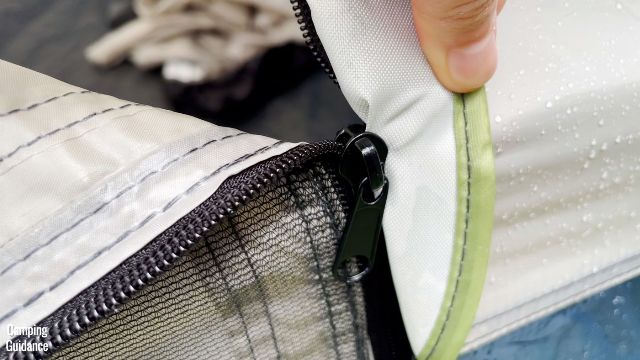
There was this sort of inconsistent mesh in 2 places, and I found some rust on the steel wall poles.
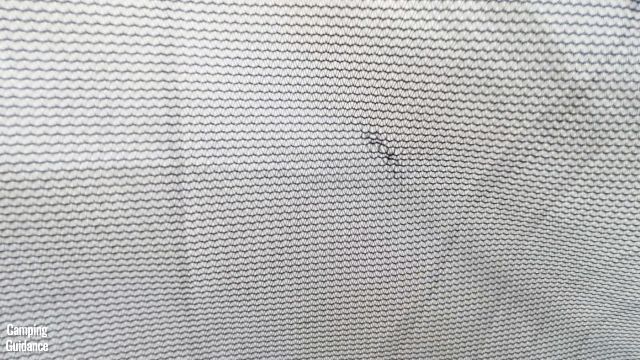
Also, right out of the box, I noticed some black stuff on my hands after touching the tent.
Quality Ratings
So, based on all the quality metrics I listed above, I rated the quality of each 10-person tent (out of 10, with 10 being the highest quality).
Here are those ratings in chart form:
And also in table form:
| 10P Tent | Quality Ratings |
|---|---|
| Columbia 10P | 10.0 |
| Outdoor Products 10P | 9.2 |
| WeatherMaster 10P | 9.2 |
| Core 10P | 8.3 |
| Coleman Instant 10P | 7.8 |
| Ozark Trail 10P | 6.3 |
Portability
For portability, I looked at the weight of each 10-person tent, as well as their packed sizes.
Weight
Here’s the weight of each 10-person tent from the lightest to heaviest:
| 10P Tent | Weight |
|---|---|
| Ozark Trail 10P | 30.0 pounds |
| Core 10P | 30.5 pounds |
| WeatherMaster 10P | 30.6 pounds |
| Coleman Instant 10P | 31 pounds |
| Outdoor Products 10P | 32.8 pounds |
| Columbia 10P | 34.4 pounds |
Packed Size
And here’s the packed size of each 10-person tent from the smallest to largest:
| 10P Tent | Packed Size |
|---|---|
| Core 10P | 29 x 16 x 12 inches |
| Ozark Trail 10P | 29 x 18 x 13 inches |
| Columbia 10P | 30 x 14 x 12 inches |
| WeatherMaster 10P | 31 x 18 x 12 inches |
| Outdoor Products 10P | 50 x 17 x 12 inches |
| Coleman Instant 10P | 50 x 17 x 12 inches |
The most important thing to bear in mind here is that 10-person instant tents are about 50 inches long, while regular tents are about 30 inches long, so instant tents are about 40% bigger.
Here’s a picture of all my 10-person tents in my yard:

Portability Ratings
So, based on the weight and packed size of each 10-person tent, I rated the portability of each 10-person tent (out of 10, with 10 being the most portable).
Actually, I just rated regular 10-person tents as a 5/10, and instant 10-person tents as a 3/10. Just to keep things simple.
Here are those ratings in chart form:
And also in table form:
| 10P Tent | Portability Ratings |
|---|---|
| Ozark Trail 10P | 5 |
| Core 10P | 5 |
| Columbia 10P | 5 |
| WeatherMaster 10P | 5 |
| Outdoor Products 10P | 3 |
| Coleman Instant 10P | 3 |
Overall Results
Based on all 7 tests above and the scoring in each test, here’s all the scores of each 10-person tent, side by side for easier comparison:

I color-coded the ratings to make it easier to look at. Green is for good, yellow is for not so good, and red is for pretty bad. The overall performance scores are in the last column.
I got to these scores by using this following weightage:
- Ease of Use: 15%
- Spaciousness: 10%
- Comfort and Features: 10%
- Ventilation: 20%
- Rain Protection: 20%
- Quality: 20%
- Portability: 5%
- Total: 100%
In case you just want the overall scores without the individual tests, here you go:
| 10P Tent | Overall Rating |
|---|---|
| Columbia 10P | 8.5 |
| Outdoor Products 10P | 8.3 |
| WeatherMaster 10P | 7.7 |
| Coleman Instant 10P | 7.6 |
| Core 10P | 7.4 |
| Ozark Trail 10P | 6.2 |
Detailed Specifications
This section contains detailed specs only. Click here if you want to skip past this section and read the buying guide instead.
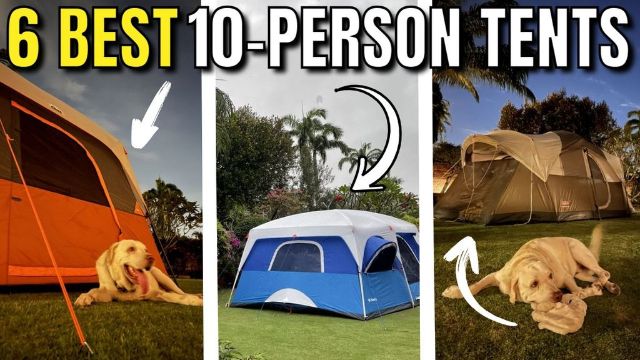
Dimensions and Measurements
| 10P Tent | Peak Height | Lowest Height | Length | Width | Base Area | Weight | Packed Size |
|---|---|---|---|---|---|---|---|
| Columbia 10P | 80 inches | 62 inches | 13 feet 11 inches | 9 feet 11 inches | 138.0 square feet | 34.4 pounds | 30 x 14 x 12 inches |
| Outdoor Products 10P | 77.5 inches | 61 inches | 13 feet 7 inches | 10 feet | 135.8 square feet | 32.8 pounds | 50 by 17 by 12 inches |
| WeatherMaster 10P | 80.5 inches | 58 inches | 16 feet 8 inches | 9 feet 1 inch | 143.6 square feet | 30.6 pounds | 31 by 18 by 12 inches |
| Coleman Instant 10P | 73.5 inches | 59 inches | 13 feet 11 inches | 9 feet 9 inches | 135.7 square feet | ~31 pounds | 50 by 17 by 12 inches |
| Core 10P | 90 inches | 65 inches | 13 feet 7 inches | 10 feet | 135.8 square feet | 30.5 pounds | 29 x 16 x 12 inches |
| Ozark Trail 10P | 88 inches | 65 inches | 13 feet 9 inches | 9 feet 11 inches | 136.4 square feet | 30.0 pounds | 29 by 18 by 13 inches |
Material and Quality
| 10P Tent | Flooring | Bathtub Feature | Tent Body | Rainfly | Poles | Zippers | Bug Net |
|---|---|---|---|---|---|---|---|
| Columbia 10P | 150D Polyester (2,000mm) | Yes (~5 inches) | 75D Polyester (800mm) | 75D Polyester (800mm) | Fiberglass x3, Steel x8 | SBS | No-see-um |
| Outdoor Products 10P | Polyethylene | Yes (5 inches) | 68D Polyester (800mm) | 68D Polyester (800mm) | Steel | No brand | No-see-um |
| WeatherMaster 10P | Polyethylene | Yes (7.5 inches) | 68D Polyester | 75D Polyester Taffeta (450mm) | Fiberglass x4, Steel x9 | No brand | Regular |
| Coleman Instant 10P | Polyethylene | Yes (4 inches) | Polyester | Polyester | Steel | No brand | Regular |
| Core 10P | Polyethylene | No | 68D Polyester | 68D Polyester | Fiberglass x3, Steel x6 | No brand | Regular |
| Ozark Trail 10P | Polyethylene | Yes (~6 inches) | 68D Polyester | 68D Polyester | Fiberglass x3, Steel x6 | No brand | Regular |
Features
| 10P Tent | Windows | Doors | Vents | Pockets | Gear Lofts | Lantern Loops | Room Divider | E-Port |
|---|---|---|---|---|---|---|---|---|
| Columbia 10P | 4 | 2 | 1 | 2 | 0 | 2 | 1 | 1 |
| Outdoor Products 10P | 3 | 3 | 1 | 2 | 0 | 4 | 1 | 1 |
| WeatherMaster 10P | 4 | 2 | 0 | 4 | 0 | 1 | 1 | 1 |
| Coleman Instant 10P | 5 | 2 | 0 | 2 | 0 | 1 | 1 | 1 |
| Core 10P | 4 | 2 | 2 | 2 | 1 | 1 | 1 | 1 |
| Ozark Trail 10P | 5 | 1 | 0 | 2 | 1 | 1 | 1 | 1 |
Usage
| 10P Tent | Set Up (2P) | Set Up (1P) | Take Down (2P) | Take Down (1P) | Guylines | Stakes | Single Pads | Queen Beds |
|---|---|---|---|---|---|---|---|---|
| Columbia 10P | 14 minutes | 28 minutes | 8.5 minutes | 16 minutes | 10 | 19 | 10 | 4 |
| Outdoor Products 10P | 6 minutes | 12 minutes | 4.25 minutes | 8.5 minutes | 6 | 15 | 10 | 4 |
| WeatherMaster 10P | 10 minutes | 19 minutes | 8.5 minutes | 16 minutes | 6 | 16 | 10 | 3 |
| Coleman Instant 10P | 7.5 minutes | 16 minutes | 5 minutes | 10 minutes | 6 | 16 | 10 | 4 |
| Core 10P | 11 minutes | 22 minutes | 7 minutes | 13 minutes | 8 | 20 | 10 | 4 |
| Ozark Trail 10P | 10 minutes | 20 minutes | 6.5 minutes | 12 minutes | 8 | 14 | 10 | 4 |
How to Choose the Best 10-Person Tent for Yourself
In addition to the 7 tests that I conducted above (ease of use, spaciousness, comfort & features, ventilation, weather protection, quality and portability), here are a few more things that you can consider when choosing the best 10-person tent for yourself and your loved ones:
- Type
- Capacity
- Shape
- Budget
Type
There are 2 main types of tents, mainly instant or non-instant (or traditional, whatever you like to call it) tents.
Instant Tents
For this review, I bought the Outdoor Products and Coleman 10-Person Instant Cabin Tents. The set up for both these instant 10-person tents are quite similar, consisting of the following steps:
First, lay the tent body flat on the ground, except for the center hub. Second, pull outward on the 6 pole or elbow joints around the tent body until half of the tent body has been propped up.


Third, extend all 6 telescoping wall poles by pulling them apart.
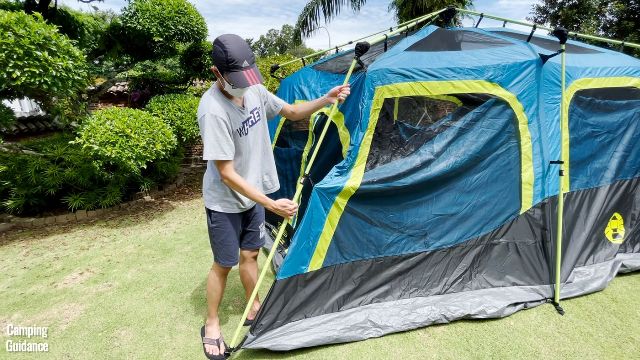
Fourth, drape the rainfly over the tent body and stake out the tent body and guylines.
(Obviously, this is an oversimplification of the 10-person instant tent set up process, but it’s the gist of it.)
Pre-Attached Poles
The reason why instant tents set up so much more quickly than non-instant or traditional tents is because there are no poles to insert through long and potentially snaggy pole sleeves. All the poles are pre-attached, so all you’ve got to do is pull these telescoping pre-attached poles apart.
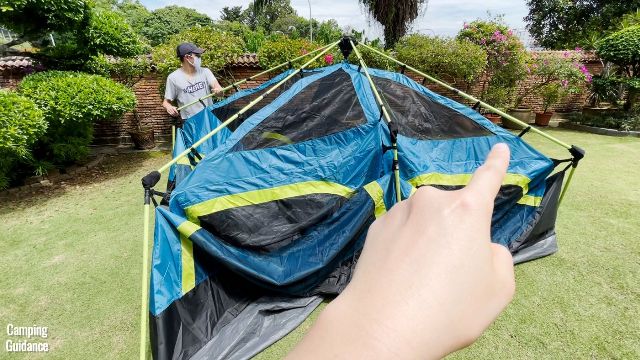
Pre-Attached Pole Clips
For both my Outdoor Products and Coleman 10-Person Instant Cabin Tents, I noticed that the pole clips connecting the tent body to the poles were also pre-attached, which also speeds up the set up process.

Pre-Attached Guylines
In addition, even the guylines (usually connected to the rainfly) will come pre-attached to the tent, also with pre-attached tensioners.

Note: In this review of 10-person tents though, every single one of my 10-person tents came with pre-attached guylines and tensioners.
Traditional Tents
For traditional or non-instant tents, you have to go through 2 additional steps as compared to instant tents:
- Inserting poles through pole sleeves; and
- Clipping the pole clips to the poles.
Poles and Pole Sleeves
So, to start off, you’d have to thread poles through pole sleeves first, before the tent body is able to be propped off the ground. This can take some time, especially if:
- The pole sleeves are long and snaggy;
- The poles and pole sleeves are not color-coded for easy identification; and
- You’ve got lots of poles to insert.
Let me show you what I mean.
The WeatherMaster 10-Person Tent comes with 3 short roof pole sleeves that I found to be pretty much snag-free, and can be easily inserted by just 1 person. Also, notice that the middle pole and pole sleeves are color-coded in red. As such, the WeatherMaster was my least time-consuming tent to set up.

On the other hand, even though the Ozark Trail 10-Person Cabin Tent also comes with only 3 roof poles, the poles are not color-coded.

On top of that, the pole sleeves are significantly longer, and I found it time-consuming to run back and forth to thread the poles through, resolve the snag issues, thread the poles through again, and resolve the snag issues again.

And my most time-consuming 10-person tent to set up was the Columbia Mammoth Creek 10-Person Tent, because it has 4 fiberglass roof poles to insert into these pretty long pole sleeves as well, not to mention the 2 additional steel roof poles that I haven’t yet inserted.

Pole Clips
On top of inserting the poles through pole sleeves, I found that my non-instant 10-person tents had a minimum of 6 pole clips (Ozark Trail 10-Person Cabin Tent) to a maximum of 10 pole clips (WeatherMaster 10-Person Tent) to attach the tent body to the nearest steel pole. This adds about a full minute to your set up process.

Pros and Cons
Here are some pros and cons of instant versus traditional 10-person tents.
Set Up
My 10-person instant tents took anywhere between 12 to 16 minutes to set up (1-person timing), while my traditional 10-person tents took anywhere between 19 to 28 minutes. This means that my 10-person instant tents took a whopping 20% to 130% less time to set up.

Also, I could set up both my 10-person instant tents on my own, while I could not set up 3 out of 4 of my traditional 10-person tents.
Pack Up
Packing up my 10-person instant tents was also significantly faster, taking anywhere between 4 to 5 minutes to pack up (1-person timing), while my traditional 10-person tents took anywhere between 6.5 to 8.5 minutes.
Packed Size
However, bear in mind that instant 10-person tents tend to have a much larger packed size than their non-instant counterparts.
From my research, my instant 10-person tents were about 50 inches long, while my regular 10-person tents were about 30 inches long, so instant tents are about 40% bigger, which is quite significant, especially if you don’t have a lot of space in your car or at home.

Ease of Cleaning
Also, I don’t think this is a significant point, but I just wanted to take note of it. I found that because my instant 10-person tents had poles that could not be detached, cleaning it was slightly more difficult.
For my regular non-instant 10-person tents, I could just flip the tent over to wash the base. Plus, I could just fold the tent to clean up the base as well.

On the other hand, because I couldn’t remove the poles of my instant 10-person tents, I couldn’t just flip the entire tent over. I had to bunch all the poles up to wash the base.

Also, whenever I wanted to roll the instant tent over to wash another part of the base, I had to move not only the weight of the tent body, but all the steel poles as well.
Capacity
The base area of all my 10-person tents ranged from 135.7 square feet (Coleman Instant 10-Person Tent) to 143.6 square feet (WeatherMaster 10-Person Tent). So, fitting 10 people into each of these tents means sleeping shoulder to shoulder with your buddy next to you.
And yes, I actually tested this out by fitting 10 single sleeping pads or sleeping bags into each tent. Check out this picture:

So, if you have 10 people that you want to squeeze into a tent, along with a bunch of camping gear, I wouldn’t recommend any of these 10-person tents. You might want to splurge on a 12 or maybe even 14-person tent instead (though I know those are pretty uncommon).
You could squeeze 8 people into these 10-person tents, by filling the tent up with 4 queen-sized camping mattresses, though bear in mind that there won’t be any leftover space for camping gear.
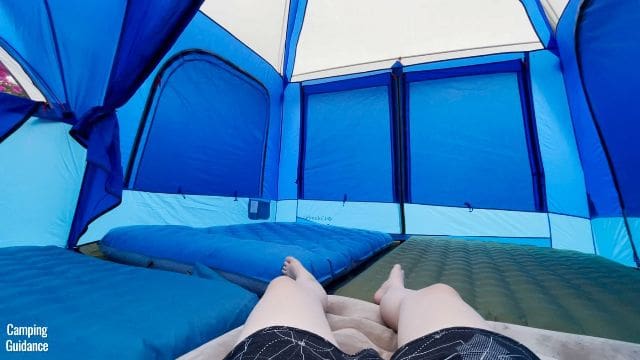
My recommendation would be to fit a maximum of 6 people into these 10-person tents, and you’d be comfortable with quite a bit of space for your gear. Or, you could fit just 4 people, and have an entire living room with tables and chairs.

Shape
There are 2 main shapes of camping tents – dome and cabin. (Of course, there are others, but we won’t be going through them now.)
Cabin
The larger the capacity of the camping tent that you’re looking for, the more likely they will be to be cabin-shaped.
In fact, 5 out of 6 of my 10-person tents were cabin-shaped, except for the WeatherMaster 10-Person Tent.

Cabin-shaped tents typically have almost vertical side walls, giving you much more livable space inside the tent. Unlike dome-shaped tents that slope downwards, cabin-shaped tents don’t slope downwards too much. In fact, you might still be able to stand up everywhere inside the tent, even at the 4 corners (where the lowest height is), like I was able to.

The main problem with cabin tents though, is that the vertical side walls can pick up a lot of wind, especially if they’re not staked down.
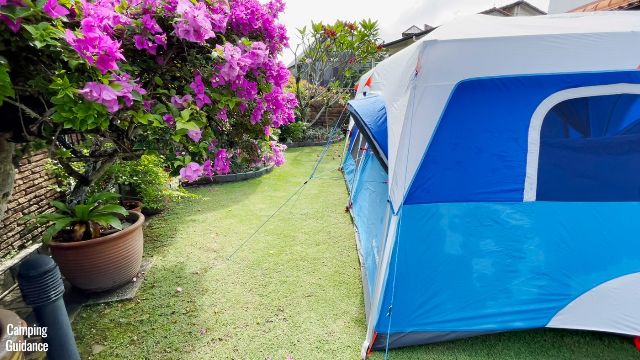
Dome
Dome-shaped tents are what its name suggests – they look like domes. They may or may not have a high peak height in the center of the tent, but slope downwards, so you won’t get that nice high peak height throughout the tent. The benefit of these tents is that there aren’t any vertical side walls that can catch a lot of wind, and they’re much more sturdy in heavier winds.
I was hard-pressed to find a dome-shaped 10-person tent, but here’s one – the Mountain Hardwear Stronghold Dome Tent.
I only wish that I had enough money to buy this tent and test it out, but it cost more than all my other 10-person tents combined, so I had to pass. Also, I haven’t been base camping (yet), so maybe next time.
Hybrid
My WeatherMaster 10-Person Tent was neither a cabin nor a dome shape, so I just decided to call it a hybrid.
The WeatherMaster Tent has vertical side walls on the front length and the back length of the tent, with a nice high peak height of slightly more than 80 inches. I was able to stand up almost everywhere inside the tent, which is typical of a cabin-shaped tent.

However, the WeatherMaster 10-Person Tent also has these significantly sloping walls at the 2 widths of the tent, to cater for the 2 angled windows.

I felt that the WeatherMaster was able to take light winds better than the rest of my tents, because it’s not exactly a cabin shaped. But even so, the vertical side walls still pick up a lot of wind.

Recommendation
Essentially, because all my 10-person tents had vertical side walls, I wouldn’t recommend any of them if you’re expecting tons of wind.
If you need something more dome-shaped to endure strong winds, you could either splash out on the Mountain Hardwear Stronghold Dome Tent, or buy multiple smaller dome-shaped tents.
But if you’re not expecting only minimal to light wind, all of these 10-person tents should do fine, as long as you stake them down.
Budget
Naturally, if you’re looking for a tent with a large capacity, it’s expected that you’re going to have to shell out more, as compared to if you were looking for a tent with a smaller capacity.
I spent a whopping $1,500 (slightly more than that, actually) on all of my six 10-person tents, and each of them ranged from about $100 to $400.
If you need something on a budget, I paid only slightly more than $100 on my Ozark Trail 10-Person Cabin Tent, so that’s worth checking out.

If you have a little bit more to spend, I paid about $250-$300 for my WeatherMaster 10-Person Tent, which was a pretty good deal.
And if you want only the premium stuff, I spent more than $400 on my Columbia Mammoth Creek 10-Person Tent, so you can check that out.
Frequently Asked Questions (FAQs)
Why You Should Trust Us
Well, unlike most 10-person tent product reviews you find on the internet, I actually own, used and thoroughly tested all of these 10-person tents. Yup, every single one.
I spent over $1,500 buying these six 10-person tents, which took me a few months of saving to do. After that, I spent at least a week in each one (so 6 weeks in total) for thorough testing, filming and data collection. And that’s not all. Finally, I spent 2-3 months after that putting together my series of YouTube videos and these blog posts on all these 10-person tents, trying to be as comprehensive as possible. Altogether, I logged hundreds of hours on these 10-person tents.
Also, I don’t accept free products from manufacturers, and don’t accept sponsored posts or YouTube videos that may cause me to give a biased review. Each and every product is bought by me with my savings, and all opinions are my own, from months of real-world testing and usage.
Conclusion
Ultimately, of all the 10-person tents that I bought and tested, I think there’s one that will best suit your needs, and here’s quick summary of all of them:
- Best Value for Money: Coleman WeatherMaster 10-Person Tent
- Best Premium Tent: Columbia Mammoth Creek 10-Person Tent
- Best Instant Tent: Outdoor Products 10-Person Instant Tent
- Best Blackout Tent: Coleman 10-Person Instant Cabin Tent
- Most Spacious: Core 10-Person Straight Wall Cabin Tent
- Budget Pick: Ozark Trail 10-Person Cabin Tent




